

















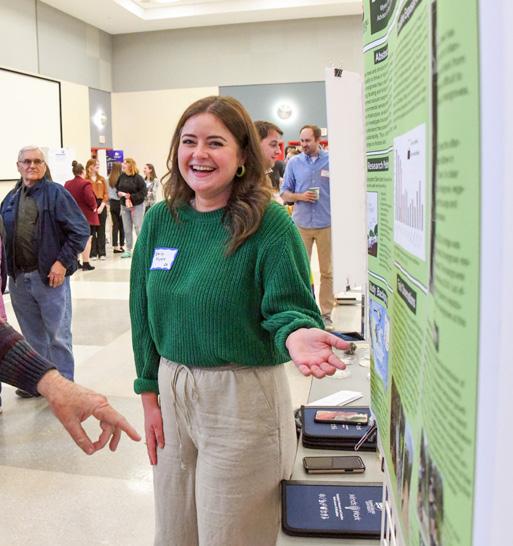






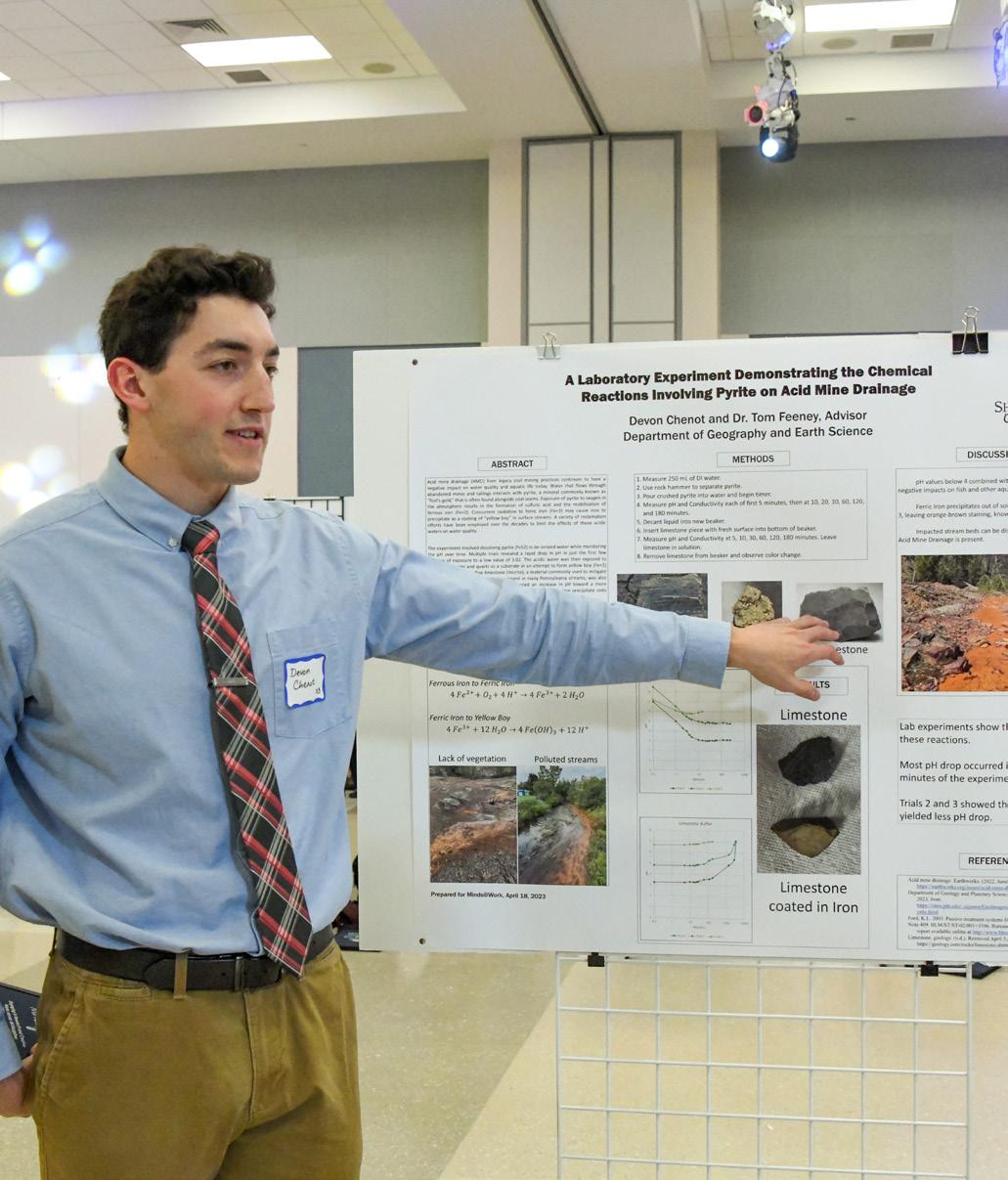




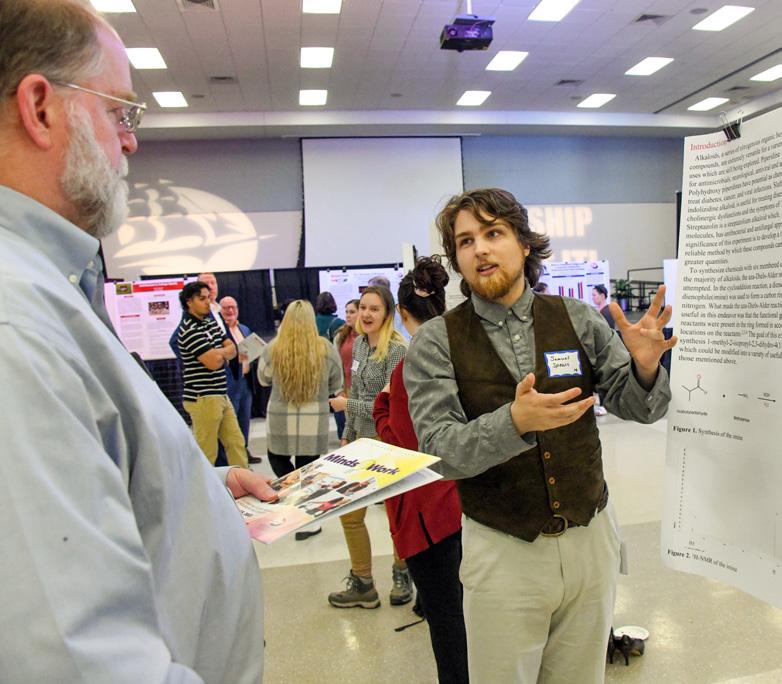














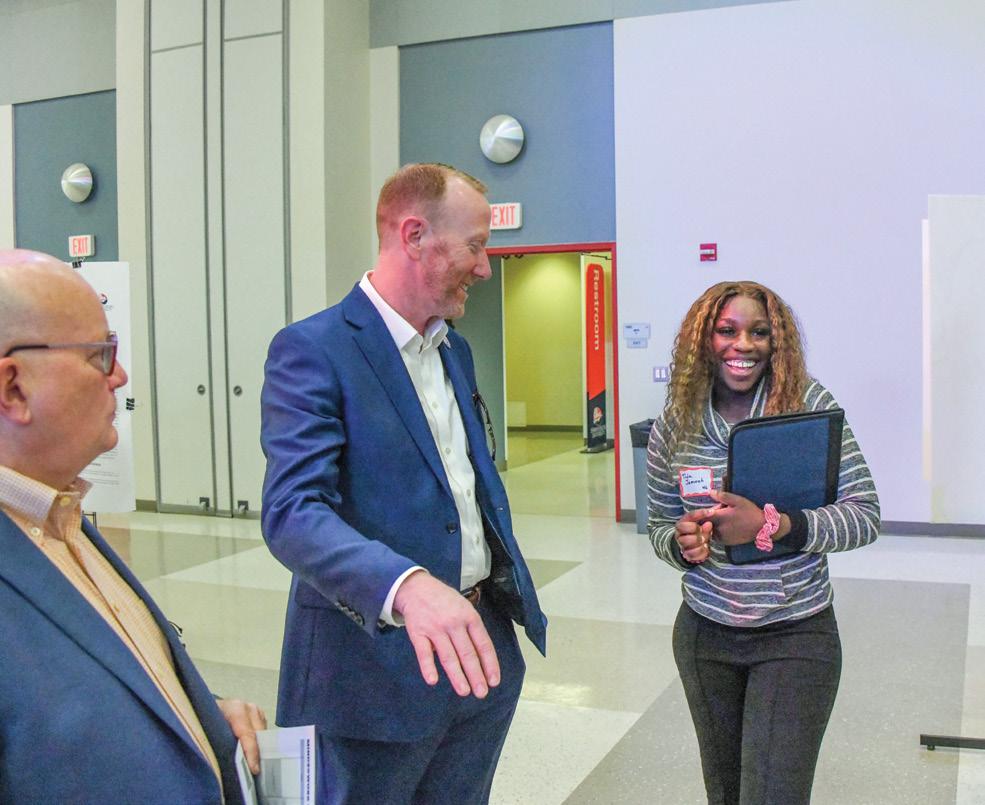










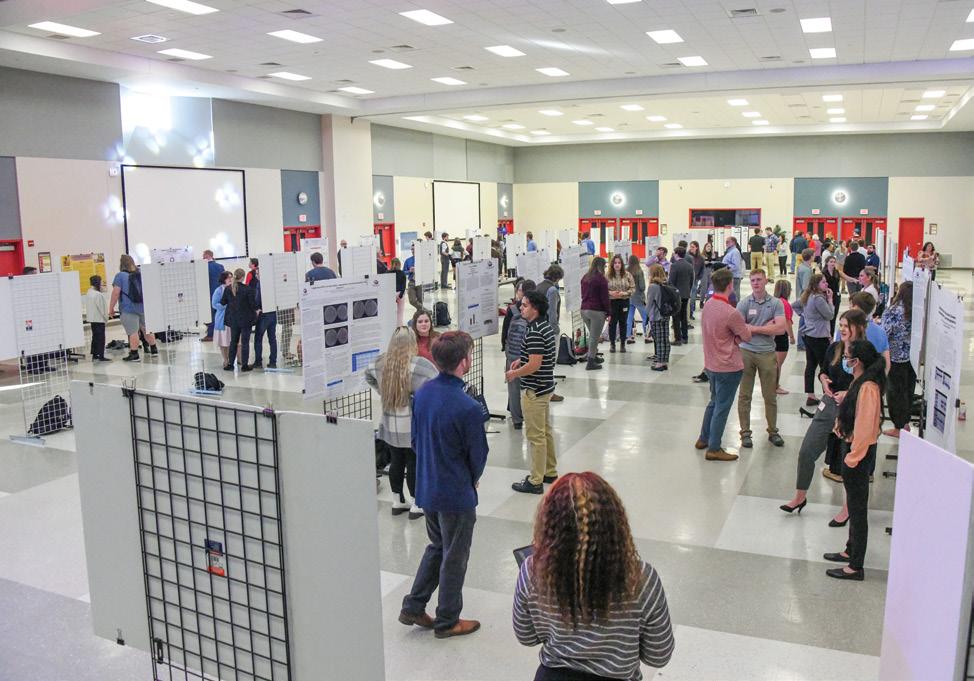
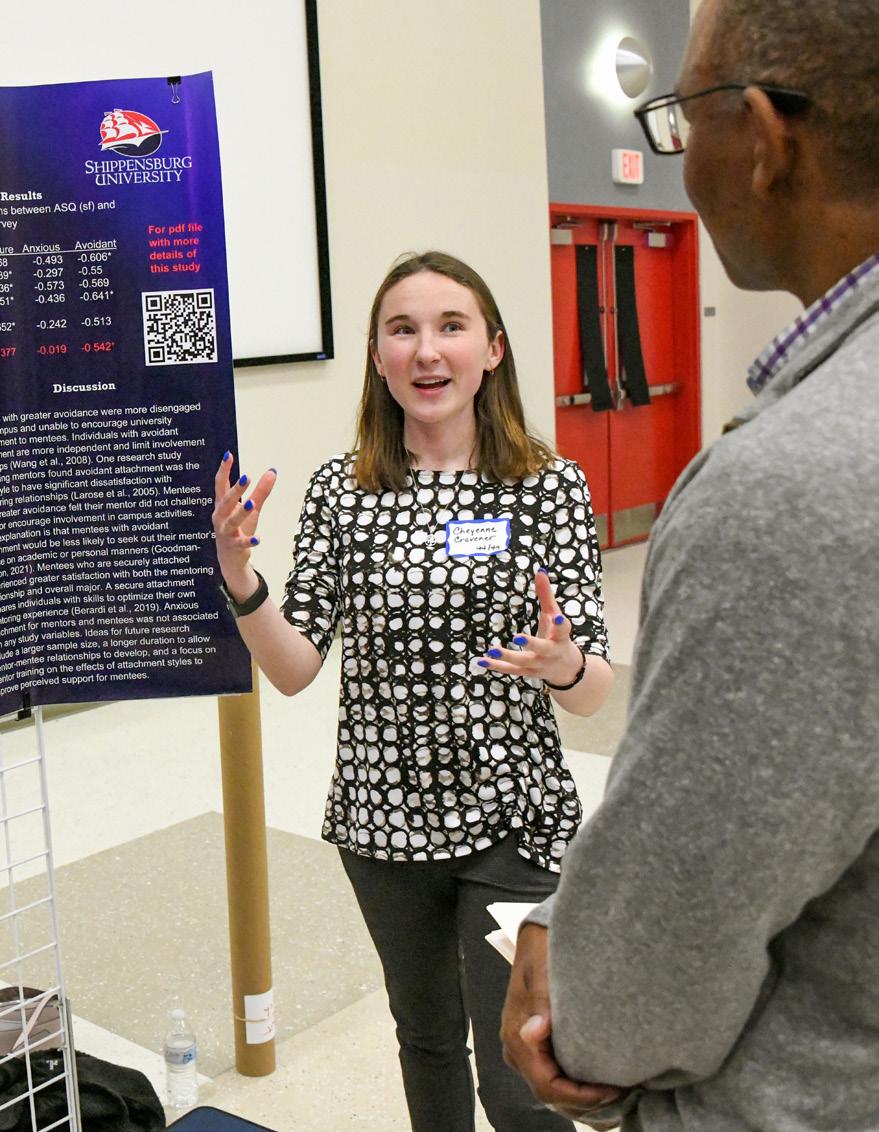

APRIL 23, 2024








CELEBRATING STUDENT RESEARCH, SCHOLARSHIP, AND CREATIVITY












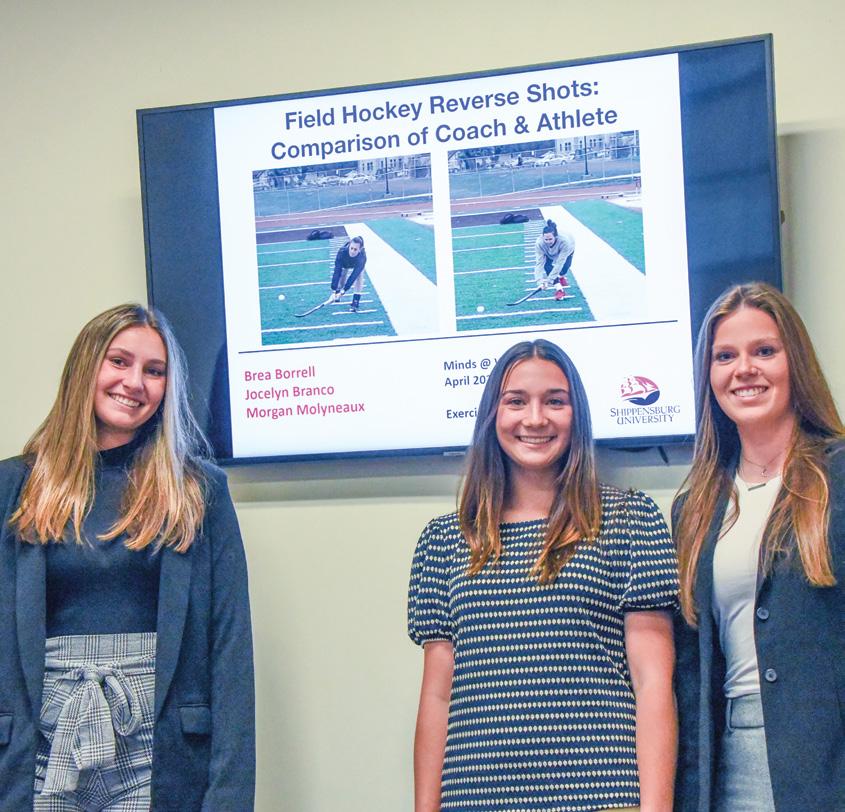








SHIPPENSBURG UNIVERSITY
TABLE OF CONTENTS From the President ...............................................................................................2 From the Interim Provost 2 On Behalf of Faculty 3 On Behalf of the SU Foundation 3 Minds@Work Coordinating Committee 4 COSRACA Members .........................................................................................4 Undergraduate Research Grant Recipients 2023–2024 5 Ezra Lehman Memorial Library Research Award 5 MINDS@WORK CONFERENCE SCHEDULE ................................ 6–7 FACULTY RESEARCH SPONSORS ................................................... 8 DEPARTMENTAL CONFERENCE PANELS ........................................ 9 Biology ...............................................................................................................11 Chemistry and Biochemistry 11 Communication, Journalism, and Media 11 Communication Studies 11 English 12 Exercise Science .................................................................................................12 Global Languages and Cultures 13 History and Philosophy 13 Political Science 13 HONORS SYMPOSIUM .................................................................. 15 Biology 17 Business ..............................................................................................................18 Communication, Journalism, and Media ...........................................................18 Communication Studies and Psychology 19 Education 20 English 21 Exercise Science .................................................................................................22 Math and Engineering 22 Natural Sciences 23 Social Sciences 23 Sociology 24 POSTERS ........................................................................................ 25 Biology 27 Chemistry and biochemistry ..............................................................................33 Communication, Journalism, and Media 33 Criminal Justice 34 Economics 34 English ...............................................................................................................35 Exercise Science .................................................................................................36 Geography and Earth Science 38 Global Languages and Cultures 40 History and Philosophy 40 Mechanical and Civil Engineering ....................................................................41 Psychology 42 Psychology and Spanish 44 Social Work and Gerontology 45 Sociology and Anthropology 46 Women’s and Gender Studies ............................................................................47
From the President
As President of Shippensburg University, it is my privilege to welcome you to Minds@ Work 2024.
Engagement in undergraduate research and creative pursuits is an increasingly significant aspect of your higher education experience. Shippensburg University has embraced the opportunity for our student scholars to engage in research and scholarly activities and to showcase the diversity of research and scholarly activity in Ship’s many academic disciplines.

Minds@Work prepares Ship students for the demands of graduate pursuits, as well as some of the challenges our students may experience in their chosen profession. Our Ship students gain proficiency in their fields of study in preparing for Minds@Work, enabling students to bridge the gap between theory and practice by providing them with hands-on experience.
This experience helps our student scholars to develop communication and presentation skills and allows them to practice articulating their ideas clearly and effectively. As a former undergraduate biochemistry researcher, I can personally attest that these skills are increasingly valuable in the professional world, where individuals must communicate and defend their ideas to colleagues, clients, and other stakeholders.
This experience is made possible through the mentorship and expertise of our dedicated faculty who prepare and guide students through this experience. Students receive additional support from our dedicated staff and industry partners who provide insight into the ever-changing professional world.
Congratulations to all our Minds@Work participants and thank you for sharing your scholarly pursuits with us each year.
Charles E. Patterson, PhD President, Shippensburg University
of Pennsylvania
From the Interim Provost
It is exciting for us to be at the moment of hosting our 2024 Minds@Work Conference, as it is a signature program of excellence for us as a campus! Shippensburg University has a long-standing tradition of convening to celebrate the exemplary research and creative activities of our students and to honor the commitment our university and faculty make to nurturing such high-impact learning for our students. I have been looking forward to this moment of the academic year as I hear about faculty and student collaborations, research endeavors, creative work accomplishments, and grant engagement. Creating a culture of inquiry during the collegiate experience is a signature commitment of our faculty, and as a University, we recognize the incredible learning that emerges in such collaborative research and creative endeavors.

The Minds@Work Conference provides an opportunity for our students to showcase their emerging skills as scholar-practitioners and to capture the impact of research and creative collaboration with faculty members. Our faculty are highly engaged in research and creative activities that advance their areas of professional expertise, and they bring this richness of scholarship and knowledge into their collaboration with students. Our students benefit from our faculty’s cultivation of their scholarly identities and the integration of professional and research-based experiences into the classroom environment. The growth and development of our students is nurtured by their participation in research and creative projects which are frequently collaborative efforts with peers and mentored by faculty. One of our strategic goals as a university is to “cultivate … dynamic educational experiences.” Research experiences at the undergraduate and graduate levels expand our students’ understanding of their responsibility to examine critical questions, apply critical thinking skills, engage in sequenced planning, and develop strategic problem solving practices. These skills provide the necessary competencies for our students to be agile as committed professionals in fields that by their very nature serve complex, dynamic, and multidimensional individuals, organizations, communities, and systems.
Through the research and creative activities presented at Minds@ Work, our students are making contributions to our communities and disciplines. For many of our students, the Minds@Work Conference is a catalyst for additional professional presentations, showcases, or publications of their scholarship.
My congratulations to all of the Minds@Work participants. I am proud of our faculty and students who actively pursue research inquiry and who elect to showcase their work at the conference. I want to especially thank the Council on Student Research and Creative Activities and the Institute for Public Service and Sponsored Programs, especially Margaret Light and Kim Taylor. I also want to thank the SU Foundation for its annual support of the Joint Faculty-Student Research Program and all the friends, alumni, and employees of the university who have generously contributed to that fund.
Nicole R. Hill, PhD Interim Provost and Vice President for Academic Affairs
2
On Behalf of Faculty
“If we knew what it was we were doing, it wouldn’t be called research would it?”
—Albert Einstein
At Shippensburg University, we lead the way in a collaborative construction of knowledge through the enterprise of faculty-student research across the disciplines that comprise our campus. The production of knowledge through the research process means we grapple with uncertainty and learn how to interpret seeming failures and insignificance as an important outcome. Whether we are engaged in research as physical scientists, musicians, social scientists, artists or writers; whether we employ experiential or experimental designs; whether our findings are distilled in tables or expressed in performance art, when we engage in research we are engaged in the production of knowledge.

On Behalf of the SU Foundation
On behalf of the Shippensburg University Foundation’s Board of Directors and staff, I want to express our best wishes to all the students and faculty who are participating in this year’s Minds@Work. The Joint Undergraduate Student-Faculty Research Program has been one of the SU Foundation’s funding priorities for decades. Over the past 10 years, the SU Foundation’s financial support of these joint research projects, from unrestricted donor contributions to the university president in the form of a grant and donor established endowments, totaled $541,563. The SU Foundation now has 14 endowments established by alumni and retired faculty donors, who value the importance of undergraduate student research.

Faculty-student research is both a process and a product of our faculty’s commitment to the engagement of our students in meaningful and transformative undergraduate education. Engagement in the research process requires a commitment to a rigorous and time intensive enterprise. Students who participate in both course based and cocurricular research projects are often found in labs, in meetings with group members and faculty mentors, and committed to the public presentation of their work. Faculty members who supervise students’ research activities lend their expertise, teach modes of inquiry and investigation outside of their credit hour workload, and spend time preparing and guiding students for presentations at conferences such as Minds@Work.
Einstein’s question drives directly to the heart of research: The systemic yet messy, exhausting but exhilarating, forward moving but often circular, creation of knowledge. Research requires the courage to move beyond what we know and plunge in to uncertainty, using only a set of methods or procedures as a guide. With practice, training, and some good luck, we come to the other side and make a contribution to collective knowledge. Here at Shippensburg University, we make that contribution together.
Aaron W Dobbs
Professor and Library Department Chairperson Scholarly Communication Librarian APSCUF-SU Chapter President
When the university and the faculty decided to make joint undergraduate and faculty research a signature experience for students, the Shippensburg University Foundation’s Board of Directors and staff enthusiastically concurred. Students at the undergraduate level, while working alongside highly qualified faculty mentors, are provided with first-hand experience early in their academic careers. Students gain presentation skills not only during the Minds@Work conference, but at judged regional and national academic conferences. These experiences build their confidence to pursue graduate studies at the master’s and doctoral levels. Past student participants in joint undergraduate student and faculty research have given testimony to the advantages they received when applying for and being accepted into prestigious health-related professional schools. This program gives Shippensburg University students an opportunity to pursue their dreams and compete for admission to competitive nationally recognized research universities.
The value of this program is well proven and has become a standing priority for the SU Foundation’s fundraising efforts. Best wishes to our students in their academic pursuits and thank you to our Ship faculty for all your great work and mentorship.
Leslie Folmer Clinton, EdD President and CEO Shippensburg University Foundation
3
Minds@Work Coordinating Committee
Council on Student Research and Creative Activities (COSRACA)
Institute for Public Service and Sponsored Programs (IPSSP)
• Margaret Light, Director
• Kimberly Taylor, Clerical Assistant 3
COSRACA members
William Braun
Kirk Moll
George Pomeroy
Kathryn Shirk
Alix Rouby
Laurie Cella
Joseph Zume
Mengzhu Fu
Joao Dias
We would like to also thank the office of Student Affairs for providing refreshments for today.
4
UNDERGRADUATE RESEARCH GRANT RECIPIENTS 2023–2024
Giovanna Osorio Abanto
Ameer Abdul’Wali
Faith Ames
Austyn Ardinger
Jack Baer
Dalton Baughman
Kelsie Baus
Jake Benarick
Emily Boger
Brett Bradybaugh
Aspen Buffington
Chase Burdick
Brighid Cantwell
Brandon Naranjo Cervantes
Kortnie Chamberlain
Grace Coffman
Larissa Cooper
Connor Crawford
Briana Abigail Czarnecki
Hope Daisley
Emilie DiGiacomo
Ally Fogelman-Wood
Brooke Fravel
Kylee Frey
Lee Garman
Caleb Gayman
Cristal Tineo Gomez
Paige Graber
Jeffrey Grimes
Ekaterina Hampton
Victoria Himmelberger
Abigail Holenchik
Tiffany Horton
Elena Monique Irons
Tristessa Iski
Wayne Jaeschke
Meghan Keiser
Mya Kemp
Caleb Kiser
Nicholas Kornilow
Kajae Larke
Kylee Long
Mackenzie Longworth
Ian Loscher
JJ Miller
Naz Miner
Leah Moffitt
Katryna Moland
Elias Ortiz
Luke Parker
Manasiben Patel
Angela Pensyl
Paulina Piecuch
Hannah Romanik
Gracie Schultz
Samaya Sharper
Jacob Shiber
Matthew Smith
John Stewart
ElliAnn Strauss
Katelyn Struminger
Emily Swartz
Hayley Taggart
Leslie Taylor
Hallie Tomczyk
Nathan VanNatter
Nicole Vela
Theresa Weber
Megan Weiss
Adeline Williams
Lilia Wiltshire
Sarah Wink
Adam Zaami
*Not all Undergraduate Research Grant Recipients will be presenting their research at this year’s conference due to the timing of the conference and nature of their research.
EZRA LEHMAN MEMORIAL LIBRARY RESEARCH AWARD
The Library Research Award is awarded annually by the Ezra Lehman Memorial Library in conjunction with the Institute for Public Service and Sponsored Programs and the Council on Student Research. This award recognizes the best literature review submitted by students who have received grant support for their participation in the annual Minds@Work Conference or by conducting other research with a faculty mentor. The first prize recipient receives a $1,000 cash prize and the honorable mention recipient is awarded a $500 prize.
Special thanks are owed to the late Professor Emeritus Berkley Laite ’67 and his wife Carol Laite ’65 who originally created and funded the early years of the Library Research Award. The Library Research Award is continued by the generous financial support of many friends of the library, through the SU Foundation.
This year’s winners are:
Winner: Jeffrey Grimes, Contrasting Approaches to Chestnut Restoration: A Comparative Study of Localized Efforts in Italy and Pennsylvania, Citation Style: Chicago Style, Dr. Allen Dieterich-Ward (Faculty Advisor)
Runner-up: Jeremy Satyawan Putra, All That and Dim Sum: Analyzing Asian Americans Contribution in Public Relations, Citation Style: APA Style, Dr. Dhiman Chattopadhyay (Faculty Advisor)
5
MINDS@WORK CONFERENCE
6 First Floor MPR 103 104 105 119 2:00pm 2:15 2:30 2:45 3:00 3:15 3:30 HISTORY AND PHILOSOPHY The Comparative Power of Comparative History 3:30pm–4:45pm 3:45 4:00 POSTER SESSION 4:00pm–6:00pm POLITICAL SCIENCE Sport, Race, and Gender 4:00pm–5:15pm CHEMISTRY AND BIOCHEMISTRY Senior Research 4:00pm–6:00pm 4:15 4:30 BIOLOGY Research in Biology Student Presentations 4:30pm–7:30pm 4:45 5:00 POLITICAL SCIENCE Democracy, Violence, and Environmental Threats 5:00pm–6:00pm 5:15 POLITICAL SCIENCE Nationalism and Activism in Sport 5:15pm–6:30pm 5:30 5:45 6:00 EXERCISE SCIENCE Movement Science and Skill Analysis 6:00pm–8:00pm 6:15 6:30 POLITICAL SCIENCE The Economic and Statist Implications of Sports 6:30pm–7:45pm 6:45 7:00 7:15 7:30 7:45 8:00 8:15 8:30 8:45 9:00 8:30 8:45 9:00
April 23, 2024
ENGLISH
“Seeing Myself in Popular Culture” The Power of Representation
ENGLISH
“The Personal is Political”
ENGLISH
Writing Dramatically: Performances of Scenes for Independent Study
7 Second Floor 226 238 240 Orndorff Theatre 2:00pm 2:15 2:30 2:45 3:00 3:15 3:30
STUDIES
Seniors Seminar Final Project Presentations 3:30pm–8:00pm GLOBAL LANGUAGES AND CULTURES Regional Variation in the Spanish Language 3:30pm–4:30pm
COMMUNICATION
Department
3:30pm–4:45pm 3:45 4:00 4:15 4:30 COMMUNICATION, JOURNALISM, AND MEDIA The World Outside and the Picture in my Head 4:30pm–5:30pm 4:45 5:00
Poets Respond
5:00pm–6:15pm 5:15 5:30 GLOBAL LANGUAGES AND CULTURES German Beer Culture 5:30pm–6:30pm ENGLISH Writing Into the Job Market 5:30pm–6:30pm 5:45 6:00 6:15 6:30
6:30pm–7:30pm 6:45 7:00 7:15 7:30 7:45 8:00 8:15 8:30 8:45 9:00 8:30 8:45 9:00
Faculty Research Sponsors
The Minds@Work Program and the Undergraduate Research Program are just two examples of Faculty-Student Research which enrich Shippensburg University’s academic environment. Our thanks to all faculty members who supported students during the 2023-2024 Academic Year.
Moayyad Al-Nasra, Mechanical and Civil Engineering
Sherri Bergsten, Biology
William Braun, Exercise Science
Steven Burg, History and Philosophy
Allison Carey, Biology
Laurie Cella, English
Dhiman Chattopadhyay, Communication, Journalism, and Media
Sean Cornell, Geography and Earth Science
Thomas Crochunis, English
Pablo Delis, Biology
Joao Dias, Mechanical and Civil Engineering
Alison Fedrow, Biology
Alison Feeney, Geography and Earth Science
Thomas Hatvany, Psychology
Tim Hawkins, Geography and Earth Science
Todd Hurd, Biology
Misty Knight, Women’s and Gender Studies
Emily Kramer, Biology
Kara Laskowski, Communication Studies
Marcie Lehman, Biology
Robert Lesman, Global Languages and Cultures
Steven Lichtman, Political Science
Michael Lyman, Social Work and Gerontology
Arelys Madero, Criminal Justice
Paul Marr, Geography and Earth Science
Robin McCann, Chemistry and Biochemistry
Ben Meyer, Exercise Science
David Monaghan, Psychology
Shannon Mortimore-Smith, English
Amber Norwood, Psychology
George Pomeroy, Geography and Earth Science
Mark Sachleben, Political Science
Joohee Sanders, Exercise Science
Nicole Santalucia, English
Toru Sato, Psychology
Heather Shali, Biology
Freddy Siahaan, Economics
Jonathan Skaff, History and Philosophy
Mark Spicka, History and Philosophy
Richard Stewart, Biology
Kim Weikel, Psychology
David Wildermuth, Global Languages and Cultures
Ying Yang, Sociology and Anthropology
Curtis Zaleski, Chemistry and Biochemistry
8





























DEPARTMENTAL CONFERENCE PANELS






































































9
Departmental Conference Panels 10
BIOLOGY
TIME: 4:30pm–7:30pm
Biology Student Research Panel
CUB 119
Undergraduate and Graduate student researchers from the Biology department will discuss their work, showing the range of exploration in biology. Research topics include assessment of wildlife populations in Pennsylvania including a bobwhite quail reintroduction, turtles in agricultural ponds, northern watersnakes in disturbed and undisturbed areas, and fish distribution in the Michaux forest. The influence of water quality on invasive and established crayfish was studied, as well as factors limiting reproduction of an endangered dwarf iris. Relevant to human disease, efficacy of tick repellants was analyzed through behavioral assays, and the relationship of the cellular recycling process autophagy with cell migration and cell death was evaluated in a brain cancer cell line.
Ameer Abdul’Wali, Nathan Alexander, Emily Boger, Brighid Cantwell, Grace Cocanower, Alicia Endress, Ekaterina Hampton, Theresa Haug, Kajae Larke, Paulina Piecuch, Leslie Taylor, Cristal Tineo Gomez, Patrick Walker
Faculty Sponsor: Sherri Bergsten
CHEMISTRY AND BIOCHEMISTRY
TIME: 3 :30pm–5:30pm
CUB 105
Department of Chemistry and Biochemistry Senior Research Symposium
This symposium will focus on the research projects performed by undergraduate chemistry majors. Research projects will include topics from the disciplines of analytical chemistry, biochemistry, inorganic chemistry, organic chemistry, and physical chemistry.
Kortnie Chamberlain, Briana Abigail Czarnecki, Kylee Frey, Elena Irons, Ian Loscher, Giovanna Osorio, Luke Parker, John Stewart, Emily Swartz, Megan Weiss
Faculty Sponsor: Robin McCann
COMMUNICATION, JOURNALISM, AND MEDIA
TIME: 4:30pm–5:30pm
The World Outside and the Picture in my Head: How Media Messages
Reinforce and Challenge Stereotypes
CUB 238
COMMUNICATION STUDIES
TIME: 3:30pm–4:45pm
Exploring Online Communication: Patterns, Privacy, and Purchases
CUB 226
This panel features research conducted by senior students in Communication Studies. Each independent capstone thesis project employs communication theory and original social scientific design to investigate the ways in which students engage in online interactions, their motivations for doing so, and the outcomes of online communication. Topics explored in this panel include Peer Communication and Purchase Patterns; Motivations for Emoji Use; The Communication about Student-Athletes in University Social Media; and, Online Privacy, and Communication in Gaming.
Jhamear Bragton, Denny Encarnacion, Alexia Kellerman, Katie Michalik, Carson Rhodes
Faculty Sponsor: Kara Laskowski
COMMUNICATION STUDIES
TIME: 4:45pm–6:00pm
CUB 226
The Role of Communication in Forming and Maintaining Relationships: Connection, Romance and Representation
This panel includes original research conducted by senior undergraduate students in Communication Studies. As part of the capstone course, each student has completed an independent senior thesis. In this panel, student research focusing on communication in relationships is presented. Topics covered include the “why” of online dating, the effects of “venting” to others on romantic relationships, the representation of communication in the film Hairspray!, F2F vs. online dating, and the consequences of relational communication on student mental health.
Allison Devlin, Mercedes Favor, Emily Fonash, Nayely Pena, Cheri Zachary
Faculty Sponsor: Kara Laskowski
COMMUNICATION STUDIES
TIME: 6:00pm–7:15pm
To Say or Not to Say: Communication Considerations and Consequences
CUB 226
This panel will explore how mass media creates, reinforces (and sometimes challenges or even demolishes) stereotypes about different minority or marginalized groups. Panelists who have created individual posters will show visual examples of such stereotyping, as also attempts to challenge them that they found on different mass media platforms (e.g., television, social media, magazines, newspapers, advertisements). They will argue how such stereotypes may affect both members of targeted marginalized groups, as well as outgroup members’ views about these marginalized groups.
Emily Beale, Gavin Cupp, Heather Kemp, Elisa Reitman, Claire Rothermel, Hailee Rauch
Faculty Sponsor: Dhiman Chattopadhyay
This panel features original, social scientific research conducted by senior students in Communication Studies. Each capstone senior thesis project presents a study that focuses on the decisions that college students engage in when considering whether and what to communicate, where, and to whom. Spanning a variety of communication contexts familiar to all students, topics presented in this panel include Choosing not to Communicate, the Communication of Eating Disorders, Communication Efforts in Online vs. F2F Classes, and Seeking Support from Faculty.
K’Nya Holmes, Bryon Jordan, Logan Kane, Olivia Kirby
Faculty Sponsor: Kara Laskowski
Departmental Conference Panels 11
ENGLISH
TIME: 3:30pm–4:45pm
ORNDORFF THEATRE
The Personal is Political: Poets Respond
This panel features original work by student-writers in Introduction to Poetry Writing (ENG 307). A student poetry reading that addresses the personal, the political, and the power of poetry. Students will present a variety of poetic styles inspired by contemporary poetics.
Students from Introduction to Poetry Writing ENG 307 will read original poems that explore technique, style, and voice. These poets individually and collectively respond to societal pressures, politics, the environment, and the art of compassion as they work to shape identities and raise awareness about many aspects of American culture.
Dan Brouse, Emilia Conners, Elise Converse, Trevor Dixon, Caylynn Felton, Ava Hawes, James Jaisingh, Pamela Kirkpatrick, Riley Martin, Tomi May, Hailee Rauch, Jenny Russell, Jake Smith, Crystal Wano
Faculty Sponsor: Nicole Santalucia
ENGLISH
TIME: 6:30pm–7:30pm
Seeing Myself in Popular Culture— The Power of Representation
CUB 240
The focus of this presentation is the importance of representation in popular culture. Research has shown that seeing your own identity reflected back to you in popular culture increases self-esteem and normalizes high achievement for minority students. Four students will describe the moment they recognized themselves in either music or film.
Ariana Kershaw, Sundus Mahamed, Emilia Sensinger, Bailey Shehan
Faculty Sponsor: Laurie Cella
ENGLISH
TIME: 5:30pm–7:30pm
ORNDORFF THEATRE
Writing Dramatically: Performances of Scenes from an Independent Study
This session will feature the performance of scenes from Margaret McGuire’s spring 2024 Independent Study in Playwriting. McGuire’s work during the semester involves exploration of forms and subjects that draw her creative attention, as well as reading varied contemporary plays that illustrate structures and forms that sometimes serve as models. Scene performances for this session will be prepared by a group of student actors working in rehearsal with McGuire and Dr. Thomas Crochunis. The audience will be invited to watch the performed scenes and then to talk with McGuire and the student actors about the work and its creation.
Katie Huston, Margaret McGuire, Pierce Romey, Kylie Saar
Faculty Sponsor: Thomas Crochunis
ENGLISH
TIME: 5:30pm–6:30pm CUB 240
Writing Into The Job Market and Grad School: Professional Experience (Writing Fellows)
Student workers who serve as Writing Fellows will discuss their experiences working for Shippensburg’s First-Year Writing Program. This discussion panel will illustrate the preparation and professionalization that shapes students in these leadership positions. Their roles and responsibilities working for the English Department are preparing them for various career paths and graduate school programs.
Hannah Cornell, Cynthia Dodd, Katie Huston, Heather Kemp, Maggie McGuire, Lauren Pool, Pierce Romey, Jenny Russell, Kylie Saar, Jean Stinchfield
Faculty Sponsors: Laurie Cella and Nicole Santalucia
EXERCISE SCIENCE
TIME: 5:30pm–7:30pm
Movement Science and Skill Analysis
CUB 105
This panel features a selection of noteworthy student projects from the Movement Science and Skill Analysis course (ESC 244). The session highlights the variety of interests of our students and includes the sports of cheerleading, softball, wrestling, and lacrosse. Presenters will provide background information, describe the methods used to examine the skill, and then share the results of their field-based research. The ESC 244 course provides students in the Exercise Science Major and Coaching Minor with initial experiences in the research process. The presentations in this session showcase the students’ first venture into research projects in the discipline.
Student presentations include: Cheerleading: Comparison of Standing Tuck and Round Off Techniques; Softball: Comparison of Sacrifice and Bunt for Hit Techniques; Wrestling: Comparison of Single-Leg and DoubleLeg Takedowns; and Lacrosse: Comparison of Crow Hop and Step Down Hitting Techniques.
Aidan Bachman, Grace DiMarzio, Joseph Hoyler, Jason Pantalone, Alexis Speicher, Mike Trainor, Jenna Trusky
Faculty Sponsor: Ben Meyer
Departmental Conference Panels 12
GLOBAL LANGUAGES AND CULTURES
TIME: 5:30pm–6:30pm
German Beer Culture: Products, Practices, Perspectives
CUB 238
HISTORY AND PHILOSOPHY
TIME: 3:30pm–4:45pm
The Comparative Power of Comparative History
This panel examines the geographic, physical, cultural, and economic factors which have contributed to the development and popularity of beer in Germany. The panel consists of the following student presentations based on individual student research:
1. German Beer Culture and Beer Drinking Vessels: An Analysis (Peter de Bruin)
2. German Beer Culture and Chemistry (Cole Pearson)
3. Corporate Economics and German Beer Culture: Products, Profits and Proliferation (August Wildermuth)
4. The Future of German Beer Culture (Lauren Free)
Peter de Bruin, Lauren Free, Cole Pearson, August Wildermuth
Faculty Sponsor: David Wildermuth
GLOBAL LANGUAGES AND CULTURES
TIME: 3:30pm–4:30pm
CUB 103
History majors will present their research on topics in comparative history. This panel will demonstrate the comparative power of comparative history with each paper comparing and contrasting contemporary institutions, ideas, or issues that existed in two different countries. Even though the specific research topics differ, the panel will have a collective goal of demonstrating how comparison can aid historians in gaining understanding of the distinctive historical patterns of individual cases, while often revealing previously unknown commonalities and connections between them.
Madison Cole
Faculty Sponsor: Jonathan Skaff
POLITICAL SCIENCE
TIME: 5:00pm–6:00pm
CUB 240
Regional Variation in the Spanish Language
Spanish is a global language with over half a billion native speakers. In Spanish Phonetics (SPN 309), students learn to catalogue the regional diversity of the language in terms of the distinct sounds native speakers in different parts of the world produce. In this panel, students will present the results of their research into the unique characteristics of the language spoken in three areas: Santo Domingo (Dominican Republic), Medellín (Colombia) and the Andalucía region of Spain. Presentations will be in English, with Spanish examples translated and explained.
JaJuan Brown, Natalie DiCriscio, Jordan McIntosh
Faculty Sponsor: Robert Lesman
CUB 103
Democracy, Violence, and Environmental Threats: The Challenges of Representing
Panama at the Washington Model OAS
This panel reviews the research, preparation, and presentation for an experiential course, PLS 347 Applied Diplomacy, in which students represent the interests of the Government of Panama. In preparation for the simulation, students were required to gather information, review government documents, and research problems affecting the Western Hemisphere, with the goal of offering potential solutions. The Washington Model Organization of American States facilitates an interactive diplomatic exchange of student delegates from approximately twenty-five universities from six countries at a mock General Assembly meeting in Washington DC. As part of the preparation for the Model, students meet and discuss issues with diplomats from several member states. During this panel, students will discuss the research required to participate in the Model, how such an experiential learning opportunity helps to augment their education on campus, what they learned about interacting with other students, and why it is important for Shippensburg University students to know and understand the problems facing the hemisphere from a different perspective.
Marlon Aristy, Stephen Kelley, Alli Lomison, Luke Rainey, Abby Reasoner, Ali Sina Sharifi, Maria Luiza Takahashi, Morgan Tarr
Faculty Sponsor: Mark Sachleben
Departmental Conference Panels 13
POLITICAL SCIENCE
TIME: 4:00pm–5:15pm CUB 104
Sport, Race, and Gender
This is one of three panels of student research from PLS 392: Sport in Comparative Political Perspective.
1. Black Lives Matter Movement: The Impact on Sports, Athletes, and Social Media (Kayla Hillaert)
2. Color and Contrast: Differentiated Treatment of Women of Color In Sports (Le’Lee Martin, )
3. Bending Gender Norms Like Beckham (Abigail Reasoner)
4. Double-Edged Sword: A Comparative Assessment of the NFL and MLB on the Treatment of Race Within Its Ranks (William Tenney)
Kayla Hillaert, Le’Lee Martin, Abigail Reasoner, William Tenney
Faculty Sponsor: Steven Lichtman
POLITICAL SCIENCE
TIME: 5:15pm–6:30pm
Nationalism and Activism in Sport
CUB 104
This is the second of three panels of student research from PLS 392: Sport in Comparative Political Perspective.
1. Nationalism in Formula 1 Racing (Marlon Aristy)
2. Sports and Politics Collide: Nazism’s Impact on Sport (Ethan Conrad)
3. The Impact of Activism: How Athletes Changed the Game (Nyla Harteis)
Marlon Aristy, Ethan Conrad, Nyla Harteis
Faculty Sponsor: Steven Lichtman
POLITICAL SCIENCE
TIME: 6:30pm–7:45pm
CUB 104
The Economic and Statist Implications of Sports
This is the third of three panels of student research from PLS 392: Sport in Comparative Political Perspective.
1. A Comparison of Government Reactions in the United States and Europe to CTE (Ashonte Brown)
2. Institutional Reactions to the 2018 and 2022 FIFA World Cups (Harun Pacavar)
3. Knockout Stage: How the Super League Was Defeated (Adam Remy)
4. Hosting the Olympics: The Real Economic Impact (Skylar Walder)
Ashonte Brown, Harun Pacavar, Adam Remy, Skylar Walder
Faculty Sponsor: Steven Lichtman
Departmental Conference Panels 14
































HONORS SYMPOSIUM



































































15
Honors Symposium 16
Wood Honors College Symposium
The Honors Symposium is the formal forum where Wood Honors College seniors present their capstone projects. The research, creative, and service-learning projects that our students present today represent the culmination of their academic experience in the Honors College. Thank you for joining us to learn about their projects and acknowledge their hard work!
BIOLOGY
TUESDAY, APRIL 23, 1:30pm–2:30pm
Extinction After Continuous vs. Intermittent Reinforcement:
HRL 005
An Examination of the PartialReinforcement Extinction Effect (PREE)
The partial reinforcement extinction effect (PREE) is a behavior principle stating that continuously reinforced behavior will extinguish faster when reinforcement is discontinued compared to intermittently reinforced behavior. However, the PREE has not held under all experimental conditions in previous research, including previous studies conducted at Shippensburg University. Using a within-subject design, two male rats were shaped to lever press on a continuous schedule of reinforcement using water as the reinforcer, and two male rats were shaped to a variable-ratio 8 schedule. Then, during the extinction phase water was no longer provided to determine the extinction rate. The rats were then exposed to the other schedule they had not yet experienced. The PREE held for three of the rats, but it didn’t hold for rat 2, showing that the PREE is not a universal principle of behavior and that more research is needed to determine the conditions under which it does not hold.
Zada Lynch
Faculty Sponsor: Kathryn Potoczak
BIOLOGY
WEDNESDAY, APRIL 24, 11:00am–12:00pm
HRL 005
Factors Limiting Reproduction in the Pennsylvania Endangered Dwarf Iris, Iris verna
Conservation of local biodiversity gains importance as climate change threats increase. Little is known about Iris verna, a state endangered wildflower in Michaux State Forest, PA. Previous research reveals I. verna is pollinator limited, so research on factors limiting reproduction was conducted in spring 2023 through hand pollination and pollen viability tests. Fruit and seed production were compared among populations. Fruit set likelihood significantly differed between populations, suggesting resource inequality. Pollen crosses increased fruit and seed set but pollen origin had no difference, suggesting bi-parental inbreeding depression isn’t causing low seed production. Controlled burn effects weren’t observed, suggesting fire doesn’t immediately increase reproduction. Pollen viability varied greatly but there was no significant difference between populations, raising concern for some individuals. This research improved knowledge of I. verna and has implications for conservation.
Leslie Taylor
Faculty Sponsor: Heather Sahli
BIOLOGY
WEDNESDAY, APRIL 24, 11:00am–12:00pm
“How Do Fungi Know That They Hit an Obstacle?”
Manasiben Patel
BIOLOGY
HRL 005
TUESDAY, APRIL 23, 1:30pm–2:30pm HRL 005
Strain Variation and Speciation of Anaplasma Phagocytophilum and Ehrlichia in Ticks Collected from Hunter-acquired White-tailed Deer
Human granulocytic anaplasmosis is a tick-borne rickettsial infection of neutrophils caused by the bacterium Anaplasma phagocytophilum. This pathogen has been known as a veterinary agent since 1932 and was first recognized as a human pathogen in 1990. Tetracyclines ar the drug of choietment of anaplasmosis; no vaccine is yet available for any species of Anaplasma. Symptoms of Anaplasma infection are flu-like that may resolve in approximately one week; in severe cases respiratory failure, organ failure, bleeding problems and polymerase chain reaction (PCR) for differentiation of human and deer Anaplasma variants. Selected positive samples will be further analyzed by DNA sequencing. ultimately death can ensue. During 2020-2021 ticks (n = 4,528) were collected by the Shippensburg Biology Department from hunter-acquired deer during organized culling events at Letterkenny Army Depot (Chambersburg, Pennsylvania). Ticks are currently being subjected to DNA extraction and polymerase chain reaction (PCR) for differentiation of human and deer Anaplasma variants. Selected positive samples will be further analyzed by DNA sequencing.
Caleb Gayman
Faculty Sponsor: Alison Fedrow
BIOLOGY
TUESDAY, APRIL 23, 1:30pm–2:30pm
A Study of the Linkage Between Autophagy and Apoptosis
HRL 005
My project analyzed the relationship between autophagy and apoptosis and its relevance to cancer treatments. This is being examined by looking at the regulation between the two pathways and observing what treatments trigger in regards to tumor progression. Further understanding of these cell processes are important in the continued understanding of cancer growth and treatment.
Brighid Cantwell
Faculty Sponsor: Sherri Bergsten
Honors Symposium 17
WEDNESDAY, APRIL 24, 11:00am–12:00pm HRL 005
Survey of Private Wells for Fluorescent Organic Matter as an Indicator of Water Quality in a Community Affected by Gas Drilling
Many residents of northern Pennsylvania use private wells as drinking water sources. However, drilling for natural gas in the region has the potential to impact water resources. We used excitation-emission matrix (EEM) detection of fluorescent dissolved organic matter (FDOM) to explore the possibility of residual groundwater contamination in an area previously impacted by drilling fluid and hydro fractured for natural gas production. Study-area wells were compared with municipal supply in the same area and other wells. Private wells and springs shared one peak near 320 nm/400 nm (ex/em) differing from municipal taps and from natural FDOM reported in the literature or measured in past studies, suggesting the need for further research to determine its source.
Hope Daisley
Faculty Sponsor: Todd Hurd
BUSINESS
WEDNESDAY, APRIL 24, 12:00pm–12:45pm HRL 005
The Impact of Social Security Claiming Age on Wealthy Retirees’ Post-Retirement Wealth Accumulation
This project delves into the evolving landscape of retirement planning, particularly the significance of Social Security in shaping retirees’ financial well-being. As a future financial advisor, the researcher aims to understand how Social Security claiming age impacts retirement wealth accumulation. Utilizing the Monte Carlo simulation and case studies, the study examines the effectiveness of different claiming ages in maximizing Social Security benefits and overall wealth accumulation for wealthy retirees. By addressing gaps in existing literature and focusing on affluent retirees, this research aims to provide valuable insights for financial planning professionals and contribute to better retirement outcomes for clients.
Cody Willoughby
Faculty Sponsor: Robert Setaputra
BUSINESS
WEDNESDAY, APRIL 24, 12:00pm–12:45pm
HRL 005
Junk Food on the Air: Food and Beverage Advertising to Children in the United States vs. the United Kingdom
In recent years, children’s exposure to digital media has surged, leading to increased screen time and heightened susceptibility to unhealthy food and beverage advertising. Concurrently, childhood obesity remains a pressing issue across numerous countries. This prompts the inquiry into the potential link between unhealthy food and beverage advertising and childhood obesity. This comparative analysis aims to analyze food and beverage advertising practices in two countries, namely the United States and the United Kingdom, to compare various socio-economic, cultural, and environmental factors that may contribute to disparities in obesity prevalence. The project will also examine regulatory measures in place to curb unethical advertising targeting children, and the prevalence of childhood obesity rates.
Jenna Walmer
Faculty Sponsor: Mohammad Rahman
COMMUNICATION, JOURNALISM, AND MEDIA
TUESDAY, APRIL 23, 4:00pm–5:00pm HRL 005
All That and Dim Sum: Analyzing Asian Americans’ Contribution in Public Relations
Diversity, Equity, and Inclusion is a common topic among professionals no matter the industry. Having a diverse workforce leads to expanded worldviews and thriving business for companies. Companies that hold diversity in high regards also hold their customers highly as well as it better reflects their diverse customer base. That being said, Asian Americans continue to be an underrepresented minority group in the public relations industry. Through prior research, this can be dated back to systemic racism in the industry, lack of inclusion-based education in the school system, and the lack of Asian American mentors that are currently in the industry. Seeing as there is little information out there, I interviewed several Asian American practitioners in the public relations industry to see what their thoughts on the matter are. The information and themes I collect from their interviews are then analyzed into a research paper that blends prior data with modern thoughts.
Jeremy Satyawan Putra
Faculty Sponsor: Dhiman Chattopadhyay
Honors Symposium 18
BIOLOGY
COMMUNICATION, JOURNALISM, AND MEDIA
TUESDAY, APRIL 23, 4:00pm–5:00pm HRL 005
Going Over C’s: Creating an Updated Study Abroad Guide for Soonchunhyang University
While studying abroad is often a student’s favorite experience in college, there are four categories that make students hesitant to participate: cost, curriculum, culture and circumstance. The program offered by Soonchunhyang University in South Korea addresses each of these categories, but the current literature about the program would be improved by offering more student-based testimonials and details. In making a media kit, my goal is to help to better explain how the SCHU program benefits participants during their travel and their overall time in college. The media kit includes samples from the travel blog I kept at SCHU in the spring of 2023, brochures about packing, traveling and quick tips, videos talking about other’s experiences at SCH, and a white paper addressing how the SCHU program covers the 4 aforementioned categories. These materials will be provided to the Shippensburg University Center for Global Education to be used for future students looking to study abroad.
Elizabeth Peters
Faculty Sponsor: Michael Drager
COMMUNICATION, JOURNALISM, AND MEDIA
THURSDAY, APRIL 25, 1:00pm–1:30pm
The Poisoning of the American Mind: Misinformation and Disinformation in America
HRL 005
COMMUNICATION STUDIES AND PSYCHOLOGY
WEDNESDAY, APRIL 24, 2:00pm–3:00pm
Humans are hard wired to look for information they agree with, avoid information that makes them uncomfortable, and interpret information that is most favorable to their sense of self. The damage these cognitive tendencies cause to one’s perception of reality depends partly upon the information a person surrounds him/herself with. In the U.S. today, both liberals and conservatives are bombarded with misleading information and lies from people they believe to be trustworthy, authoritative sources. While several factors could plausibly explain this predicament, the decline in the quality of the sources the right and left rely on over the last few decades plays a primary role. We are faced with an epistemic crisis that is poisoning the American mind and threatening our democracy. My documentary, The Poisoning of the American Mind, explores epistemic problems in both right- and left-wing ideological silos, including ideology presented as fact, misinformation, disinformation and malinformation.
Allyson Ritchey
Faculty Sponsor: Lawrence Eppard
HRL 005
Examination of Shippensburg University Student Attendance at the H. Ric Luhrs Performing Arts Center
This study aims to uncover the motivations and attitudes that drives students’ attendance to shows at H. Ric Luhrs Performing Arts Center. Despite the importance of student participation, there remains a gap in understanding their reasons for attending or their resistance. By delving into students’ perception of Luhrs Center and its offerings, this study seeks to discover insights that can inform targeted marketing approach. By discerning the factors influencing students’ decisions regarding Luhrs shows, innovative marketing strategies can be devised to better appeal to Shippensburg University students, ultimately leading to increased students attendance. The findings regarding the students’ motivations and attitudes of Luhrs’ performances, along with proposed marketing strategies will be presented. Emily Fonash
Faculty Sponsor: Mohammad Rahman
COMMUNICATION STUDIES AND PSYCHOLOGY
WEDNESDAY, APRIL 24, 2:00pm–3:00pm HRL 005
Integrative Care: The Influence of a Mental Health Navigator on Mental Health Outcomes for Identified Patients in a Primary Care Setting
The purpose of this study is to explore the mental health outcomes of identified patients in primary care when having the support of a mental health navigator (MHN). MHN’s offer structured support to participants seeking therapy. Integrative care models have shown to improve access, reduce symptom severity, and address mental health care barriers. Participants were recruited through primary care offices and open community sources. Preliminary investigation assessed provider attitudes using selected questions from the MICA-4 scale. MHN participant surveys covered demographics and mental health assessments with follow-up surveys covering service experiences and outcomes. This approach assesses the impact of MHN support on mental health outcomes and provider attitudes, contributing insights to the integrated mental health care model of delivery. Further hypotheses and results will be presented at the Honors Symposium.
Abigail Holenchik, Adeline Williams
Faculty Sponsor: Amber Norwood
Honors Symposium 19
EDUCATION
WEDNESDAY, APRIL 24, 5:00pm–6:15pm HRL 005
Assessment in the High School Chemistry Classroom
In the high school chemistry classroom, there are a variety of ways that a teacher can create assessments for students that challenges, develops, and recontextualizes the way they understand the course material. These assessments will try to fulfill the needs outlined in Bloom’s Taxonomy, which provides a framework for the learning objectives that a teacher should assess their students on, with this framework being set up in a hierarchical manner. There have been many efforts to create standards for teachers that make sure they are following this framework, with this being true for the National Science Teacher Association (NSTA) standards. These NSTA standards were utilized to create an assessment portfolio that aims to assess students on their understanding of content knowledge in chemistry, assess students on their ability to perform hands-on chemistry practices and applications of chemistry, and includes assessments that incorporates all students in the classroom.
Mark McKenzie
Faculty Sponsor: Joseph Shane
EDUCATION
WEDNESDAY, APRIL 24, 5:00pm–6:15pm HRL 005
Beyond Exposition: Teaching Creative Writing in the Secondary English Classroom
Throughout my time student teaching in a 7th Grade ELA classroom at Chambersburg Area Middle School North, I am attempting to answer the question: How can English teachers effectively implement creative writing into their ELA classrooms as an alternative to expository writing assignments? In the current educational environment, students are asked to write in very rigid, formulaic structures that may limit their responses to a very narrow margin of originality. Many middle and high school students, in my experience, also greatly dislike writing and find it very challenging. With a series of creative lessons and assignments that I provided to students during my 16-week placement in the middle school, I have been analyzing student writing, learning how students interact with creative writing differently than expository writing, and tracking if their writing skills have improved with the help of these creative assignments. I have focused not only on numerical grades, but also student engagement and opinion, to determine my results.
Emily Dziennik
Faculty Sponsor: Shannon Mortimore-Smith
EDUCATION
WEDNESDAY, APRIL 24, 5 :00pm–6:15pm
Teaching in a Virtual Age: How to Assess the Students
HRL 005
In the age of virtual learning, an increasing number of assessments are online. The goal of this paper was to collect data in the classroom to see firsthand what assessments the students preferred, but also to see which they did better in while monitoring academic honesty. To do this, the students in the classroom were given a pencil and paper test, and their grades were collected. On the next unit, the students were given the unit test online. After taking both, a survey was sent asking them a few questions. The questions were about which type they prefer and why, and then a question asking which they felt they did better on. Based on the initial research, right under three quarters (72.2%) of my students preferred the online tests, and the remainder preferred the paper test. Interestingly, there were 2 students who preferred one type, but they thought they did better on the other type.
Jack Myers
Faculty Sponsor: Joseph Shane
EDUCATION
WEDNESDAY, APRIL 24, 5:00pm–6:15pm
Third Grade Minds at Work: Using Engineering Curriculum to Enhance Student Learning
HRL 005
While the latest technology and researched teaching strategies have found their way into elementary classrooms across the United States, educators in the Dominican Republic need strategies to supplement their teaching that allow students to experience hands-on learning. Studies have found that students learn best through play-based learning. Implementing engineering is the perfect example of this, as it provides students opportunities to build their own creations while also using skills developed in core subjects. As elementary students get older, hands-on learning is often taken away. However, play-based learning is still effective for upper elementary students. Combining the developmental needs of third grade students and the research on engineering at the elementary level has resulted in a curriculum manual that enhances third grade students’ learning by implementing engineering concepts across all content.
Paige Smith
Faculty Sponsor: Christopher Keyes
Honors Symposium 20
ENGLISH
WEDNESDAY, APRIL 24, 6:30pm–7:45pm
Fair Maids, Fair Winds: Early Modern Depictions of White Womanhood and Wind in Thomas Heywood’s The Fair Maid of the West
HRL 005
ENGLISH
WEDNESDAY, APRIL 24, 6:30pm–7:45pm
A Space in the Trees
Thomas Heywood’s 1597 play The Fair Maid of the West dramatizes the Early Modern English cultural concern with wind. The first part of Heywood’s play to demonstrates how fictional depictions of the wind, in association with women, aid in the construction of an aspirational white womanhood for Elizabethan white Englishwomen. Heywood’s heroine Bess Bridges is a paragon of white womanhood, though she begins the play as a lowly barmaid. Bess’s Englishness and virginal alignment with Elizabeth I and the wind allow for her to pursue great riches, regardless of what violence or trickery must be enacted on those she procures money from. Her transformation from barmaid to object of a Moroccan king’s affection is aided by the figurative and literal wind that surrounds and moves her throughout the play.
Margaret McGuire
Faculty Sponsor: Jordan Windholz
ENGLISH
WEDNESDAY, APRIL 24, 6:30pm–7:45pm
HRL 005
My Honors capstone project, A Space in the Trees, is a collection of poetry written throughout my time here at Shippensburg University. During my undergraduate experience, I learned a lot about how poetry can be used to “write back” against various forms of oppression and create space for diverse expression. This chapbook aims to do the same, as the poems within it capture my experiences and focus on themes of love, loss, heartbreak, pain, violence, expectation, oppression, and control with the intention of speaking out against injustice and destroying harmful dominant discourses. Many of these writings also interact with or respond to works created by a diverse range of writers, who themselves offer up expressions of identity, experiences with hate, oppression, and/or unfair expectation. The chapbook’s title poem, A Space in the Trees highlights what this work aims to do—which is create a space where all people can be recognized, accepted, and loved for who they truly are.
Hannah Cornell
Faculty Sponsor: Nicole Santalucia
ENGLISH
WEDNESDAY, APRIL 24, 6:30pm–7:45pm
HRL 005
Hybridity in the Contemporary: Challenging the Traditional Constraints of Poetry and Genre
As our country considers the ongoing influence of forms of societal oppression on our contemporary society, and as we look for ways to combat and disentangle ourselves from these narratives, poetry is one of the most revealing and enlightening avenues to explore. Throughout history, literature has been used to communicate and subvert cultural standards, morals, and dominant ideologies and perspectives. I created a chapbook of original poetry and creative nonfiction which challenges the boundaries and constraints of conventional poetry and prose and enters the highly diverse and dynamic world of contemporary poetry. This project correlates with my interest in contemporary writing, personal narrative, and creative expression. Through my own experimentation with the boundaries of genre, I am subverting traditional literary history in favor of my contemporary understanding of my culture, society, and country within a collection of poetry.
Olivia Chovanes
Faculty Sponsor: Nicole Santalucia
HRL 005
Ugly Love: How Colleen Hoover Uses and Romanticizes Abuse
Colleen Hoover is a “#1 New York Times Bestselling Author,” and in 2022, her books sold better than the Bible. Her influence is immense. Hoover, a new-adult fiction writer, has been publishing books since 2012 and has more recently gained traction on “BookTok” for her emotionally engaging work. Yet, her books also receive constant backlash for their content. Hoover’s work has been under scrutiny specifically for its romanticization of abusive behaviors. Many of Hoover’s love interests are examples of toxic masculinity; they promote gender stereotypes, break down the female protagonists and even abuse them, all for the sake of compelling, evocative plot points. For a writer whose work primarily appeals to young women, this is damaging. I examine tropes present in new-adult fiction and romance literature, instances of abuse in Hoover’s work, and dissect how Colleen Hoover uses abuse and why this is a concern for an impressionable audience.
Piper Kull
Faculty Sponsor: Erica Galioto
Honors Symposium 21
EXERCISE SCIENCE
THURSDAY, APRIL 25, 12:00pm–1:00pm
HRL 005
Changes in Anaerobic Power of Swimmers after an Intensified Training Phase
This study investigated the effects of a two-week intensified training period on the anaerobic capacity of Shippensburg University Swim Team athletes. The study used 7 swimmers (SG) and 5 non-athletes (CG). The Wingate Anaerobic Power Test was used to measure anaerobic power. Testing days were held two weeks apart and compared baseline data to post-treatment data. Intervention for the SG involved training at a higher than usual intensity. Peak power, mean power, and fatigue index were derived. Blood glucose and blood lactate levels were obtained in the SG. The SG showed a trend (P=0.085) for improved anaerobic leg power and significantly lower (P=.026) lactate accumulation in the leg power test. Analyses revealed a non-significant improvement in peak arm power. No differences between mean power, fatigue index, or blood glucose were shown in either group. Results conclude that an intensified period of training does reduce anaerobic stress and tends to improve peak anaerobic leg power.
Faith Ames, Mackenzie Longworth
Faculty Sponsor: Turi Braun
EXERCISE SCIENCE
THURSDAY, APRIL 25, 12:00pm–1:00pm
HRL 005
The Effect of Aerobic Training Intensity on Stress and Mood
One of the more widely used methods for dealing with stress is exercise. This study examines whether aerobic intensity differently affects stress and mood levels. The study included 25 college student track athletes. 25 college students (not athletes) served as the control group. Every two weeks over a four week period, a survey gauged stress levels and mental health. Groups completed the Perceived Stress Scale and the Recovery-Stress Questionnaire. Females had a higher perceived stress score (p <0.05) than men. The 800m/1500m group reported feeling vulnerable to injury at the highest rate (p=0.003). There was no significant difference in stress levels between the three training groups or the control group. Training groups had little to no effect on stress levels in collegiate athletes.
Isabella Weikert, Jacob Shiber
Faculty Sponsor: Joohee Sanders
MATH AND ENGINEERING
TUESDAY, APRIL 23, 2:30pm–3:45pm HRL 005
Baseball Wireless Communication Device
Our project developed wireless baseball communication devices that adhere to general rules that are dramatically changing how communication in baseball will operate. Most of these rules revolve around communication between players and coaches for pitch type, shifting, location of pitch, etc. In recent years stealing signs in an unethical way has been broadcasted and talked about in national news. Due to this, baseball across all age groups is looking to move to technology to allow for a safer way to communicate between players and coaches and foster a fair game to be played. Wireless technology does exist for baseball, however there are various issues with the current state of development. The tech is somewhat unreliable, sparse, fragile, and expensive. We are producing not only reliable and readily abundant tech, but also affordable and durable devices. Thus, we hope to create affordable communication devices not only for colleges, but every other level of baseball as well.
Brett Kalfas, Gabriel Stotler
Faculty Sponsor: Sangkook Lee
MATH AND ENGINEERING
TUESDAY, APRIL 23, 2:30pm–3:45pm HRL 005
Hybrid Sliding Window Bagged Support Vector Regression Model for Stock Market Forecasting
For decades the predictive power of machine learning methods has been employed in business to guide decision-making and identify areas of weakness within organizations. Despite this, economics experts have believed that stock market behavior could never be accurately predicted due to the tremendous number of variables that influence stock prices. With the rapid improvement of machine learning and artificial intelligence techniques, this assumption is being brought into question. I researched combining two different models—Support Vector Regression and ARIMA. I explored methods of increasing each model’s accuracy and maximizing their computational efficiency by using a sliding window and ensemble learning techniques such as bootstrap aggregation. The resulting hybrid models were then tested on five different stocks from varying business sectors and tested in a simulated trading scene.
JaJuan Brown
Faculty Sponsor: Grant Innerst
MATH AND ENGINEERING
TUESDAY, APRIL 23, 2:30pm–3:45pm
Hydraulic Hitch Carrier System
HRL 005
The objective of this senior design project is to develop a versatile hydraulic hitch carrier system which can support cargo with a maximum weight of 300 pounds. The hydraulic lift system was implemented in our design as it was found that its capabilities meet the desired design requirements. This system is intended for transporting a wide range of items including, but not limited to, motorcycles and dirt bikes.
Riley Duckhorn
Faculty Sponsor: Joao Dias
Honors Symposium 22
NATURAL
SCIENCES
TUESDAY, APRIL 23, 12:30pm–1:30pm
HRL 005
Investigating the Impact of Sugar Source Variation on Kombucha Fermentation
Kombucha is a fermented tea beverage that has experienced a recent boost in popularity due to the health benefits derived from its probiotic properties. The science surrounding kombucha has become increasingly significant as brewers attempt to optimize the fermentation process to create the most appealing product possible. The fermentation of tea to produce kombucha requires a symbiotic culture of bacteria and yeasts (SCOBY), sugar, and water to produce components that effect the flavor profile of the beverage, such as alcohol and organic acids. Varying the starting sugar food source between glucose, sucrose, and fructose has been shown to affect the concentrations of each component in the beverage. Time dependent data was acquired using techniques such as potentiometric titration, nuclear magnetic resonance, and high-performance liquid chromatography.
Briana Abigail Czarnecki, Ian Loscher
Faculty Sponsors: Jeb Kegerreis, John Richardson
NATURAL SCIENCES
TUESDAY, APRIL 23, 12:30pm–1:30pm
HRL 005
Investigating the Invasiveness of Pennsylvania Non-Native Plant Species vs. Native Species After Disturbance
This study aimed to observe native versus non-native plant dynamics after a disturbance around the Shippensburg University biology pond. By clearing plots of all vegetation in Fall 2022, we could observe the first species to grow in the spring. With many invasive species thriving after disturbance, we hypothesized a higher proportion of invasive species when data was collected in September 2023, which would suggest that letting disturbed sites grow naturally will lead to invasion. We found that the proportion of native versus invasive species was not significantly different from one another (p = 0.47, 0.59). The most abundant native species included Rubus enselii and Toxicodendron radicans, and the most invasive species were Hedera helix and Microstegium vimineum. These results did not support our hypothesis. We suggest that further studies should observe these dynamics over a longer period to study native and invasive plant interactions further.
Alyssa Tomb
Faculty Sponsor: Heather Sahli
NATURAL SCIENCES
TUESDAY, APRIL 23, 12:30pm–1:30pm
Urban Heat Island Effect on Taraxacum officinale Spring Flowering Phenology, in Waynesboro, PA
HRL 005
Urban heat islands (UHI) are the phenomenon in which a warmer envelope of air is present over urban areas. Prior studies found that spring plant phenology in urban areas showed advances when compared to rural areas. The purpose of this study is to research the phenological effects of UHI’s on Taraxacum officinale (dandelions). Land surface temperatures (LST) of Waynesboro, PA were calculated from LANDSAT 8-9 satellite imagery. The dandelions were observed based on 5 stages of flower. The mean LST in the urban area was 3.35 °C warmer than in the rural areas. The first dandelions observed occurred on 03/20/2023 and only within in the urban study area. On the second observation of 04/11/2023, the dandelions in the urban study area were 39% past flowering, while 3% were past flowering in the rural study areas. Only the urban study area reached the final flowering stage. Research on the impacts of changing plant phenology is important in understanding the consequences of urban landscapes.
Jordan Flook
Faculty Sponsor: Scott Drzyzga
SOCIAL SCIENCES
TUESDAY, APRIL 23, 5:00pm–6:15pm HRL 005
Contrasting Approaches to Chestnut Restoration: A Comparative Study of Localized Efforts in Italy and Pennsylvania
This project focused on the reintroduction efforts of Castanea dentata and sativa after the Chestnut Blight in the early 20th century. By asking how and why organizations have transitioned from focusing on Cryphonectria parasitica to addressing broader environmental challenges facing chestnut conservation efforts, I determine the causes for this social and scientific shift. I used case studies of the Pennsylvania Chapter of the American Chestnut Foundation and the Chestnut Study and Documentation Center in Italy. I examine the historical and contemporary challenges, emphasizing threats posed by elevated global temperatures and forms of infection as the leading causes of concern in both regions. Other emerging diseases like brown rot caused by Sclerotinia pseudotuberosa (Black Rot), Gnomoniopsis castaneae (Brown Rot), or a change in propagule deposition patterns of pathogens make the endeavor of returning chestnut trees to their natural habitats incredibly difficult.
Jeffrey Grimes
Faculty Sponsor: Allen Dieterich-Ward
Honors Symposium 23
SOCIAL SCIENCES
TUESDAY, APRIL 23, 5:00pm–6:15pm
How Sure Are You?: Interpretations of the Beyond a Reasonable Doubt Burden of Proof
HRL 005
SOCIOLOGY
TUESDAY, APRIL 23, 11:30am–12:00pm HRL 005
Place Matters
My research focused on the interpretation of the beyond a reasonable doubt burden of proof standard used in criminal trials and the level of certainty the public feels is necessary in order to convict someone of a crime. Although this level of certainty should remain stable no matter the crime, I think it will change depending on how much emotion the crime evokes. In addition, my research will also examine whether race of the victim/perpetrator impact the level of certainty across different types of criminal offenses. This research will shed light on potential juror’s pre-trial biases that may be related to certain types of criminal cases.
Nicole Daudelin
Faculty Sponsors: James Griffith, Lawrence Bailey
SOCIAL SCIENCES
TUESDAY, APRIL 23, 5:00pm–6:15pm
Into the Meta-Verse! A Meta-Analysis of Meta-Analyses on Methadone in Association with Treating Opioid Use Disorder
HRL 005
My research project examined the growing empirical evidence that the communities where American children spend their formative years—not just the households they are raised in but where those households are located—matter for their prospects of success in subsequent stages of their lives. The authors explore the various community characteristics—including social capital, family structure, school quality, and income—associated with educational attainment, health, teen pregnancy, social mobility, violence, crime victimization, and more.
Kayla Dalhouse
Faculty Sponsor: Lawrence Eppard
Medication is a common treatment for opiate dependency, and one of the more controversial is Methadone, a type of synthetic opioid agonist that mimics the way opioids act on the body. Many professionals have called into question the efficacy of this drug, so this paper will help prove or disprove the success of Methadone on OUD. The purpose of this study is to solely focus on the effectiveness of methadone maintenance treatment programs on opioid addiction and its subsequent symptoms. These symptoms can include withdrawal, cravings, retention, and relapse rates, as well as other medically defined addiction factors. With this, we will categorize and code each study by the type of data that was collected in each. We will then be running a statistical analysis of our data, using meta-analytical models. These will be simplified from a meta-analysis, as we will be conducting an overarching umbrella review.
Emma Trate
Faculty Sponsor: James Griffith
Honors Symposium 24






























POSTERS





































































25
Posters
All poster presentations will be held in CUB MPR from 4:00pm–6:00pm 26
*
Analysis of Babesia Species in Ticks
Collected within the State of Pennsylvania
The genus Babesia is composed of apicomplexan parasites capable of causing human babesiosis, which targets red blood cells. Transmission to humans occurs through a tick bite, usually via hard-bodied ticks (Ixodes scapularis). Human-to-human spread of the potentially deadly disease has been documented to occur through blood transfusion. To date, there are multiple Babesia species that have been observed to cause infections in humans, with Babesia microti and Babesia duncani being the most commonly observed. Though some cases of babesiosis can be asymptomatic, there are cases of serious infection and even death caused by these parasites. Atovaquone combined with azithromycin or clindamycin and quinine are often used to treat the disease, but immunocompromised individuals are susceptible to prolonged/chronic illness. Although B. microti and B. duncani are the most well-known and characterized species of Babesia known to cause human babesiosis, there is evidence to suggest that additional species of Babesia are capable of being transmitted to humans by tick-bite (Babesia odocoilei). During the past decade, the Department of Biology at Shippensburg University has undertaken several studies examining tick prevalence throughout Pennsylvania. Archived ticks are currently being assessed via polymerase chain reaction (PCR) for detection of Babesia species. Samples that are positively identified for the presence of Babesia sp. will subsequently be subjected to DNA sequencing procedures for speciation.
Julia Barnhart, Cejay Cocco, Phylicia Hockman, Meghan Keiser
Faculty Sponsor: Alison Fedrow
BIOLOGY
Are Hypomodified tRNAs Degraded Upon Retrograde Nuclear Import?
Transfer RNAs (tRNAs) play an essential role in synthesizing proteins by delivering amino acids (the building blocks of proteins) to the ribosome, the site of protein synthesis in cells. Mistakes in this process can lead to abnormal proteins, which can negatively impact cell structure and function. Aberrant tRNAs, including tRNAs lacking certain nucleotide modifications, can potentially lead to errors during protein synthesis. Some nucleotide modifications are added to tRNAs after their synthesis in the nucleus, before the tRNAs are exported to the cytoplasm. All tRNAs undergo constitutive import back into the nucleus, via a pathway called retrograde tRNA nuclear import, and are ultimately re-exported back to the cytoplasm, where they function in protein synthesis. The function of this nuclear import is not fully understood, but in part is thought to play a role in proofreading tRNAs. This project seeks to determine whether two aberrant tRNAs missing a specific nucleotide modification are degraded upon nuclear import by two different pathways, the nuclear exosome and the rapid tRNA decay pathway. Preliminary RT-PCR results show that hypomodified tRNAs may accumulate in cells lacking a functional nuclear exosome, suggesting that they are normally degraded by the exosome upon nuclear import. Future experiments will quantify hypomodified tRNAs using qPCR.
Victoria Himmelburger, Tristessa Iski, Wayne Jaeschke, Mansi Patel
Faculty Sponsor: Emily Kramer
BIOLOGY
Biology Pond Management of Sport Fish Ratio
The Shippensburg University Biology Pond has provided students and faculty with opportunities for hands-on learning across multiple courses. This research explores the gamefish (Bluegill, Pumpkinseed, and largemouth Bass) populations of the Bio Pond using three strategies: Mark and Recapture, Proportional Stock Density, and analysis of Age Classes. Determining population size, game fish ratios, and generational success, can provide future insight to pond management strategies and provide background knowledge of the location for future research ideas.
Isabella Cyr, Eleanor Meckley, Sophia Smith, Dylan Stitt
Faculty Sponsor: Todd Hurd
BIOLOGY
Comparative Analysis of Fungal Distribution in Agricultural versus Natural Lands in Letterkenny Army Depot, South-Central Pennsylvania
For more than one century, large scale pollution has deeply and detrimentally impacted our environment. One main contributor to environmental pollution is modern agricultural practices, which use pesticides, fertilizers, hormones, and antibiotics to optimize crop yield. Such technologies involve chemicals that often wash into surrounding areas, adversely affecting the health of the ecosystem. Fungi, critical decomposers in most ecosystems, are negatively affected by pollution from agriculture. However, the extent to which they are affected is unknown in SouthCentral Pennsylvania. Without these crucial decomposers, our ecosystems would not be able to recycle and replenish essential nutrients, leading to environmental collapse. This study serves an expansion to a prior survey conducted in 2022 and 2023 on the fungal community of Letterkenny Army Depot, in Franklin County, Pennsylvania. In 2023 and 2024 we aim to compare the fungal communities growing near agricultural land to those found near more natural areas. Specifically, we want to address species richness, relative abundance, and overall diversity to assess the extent in which agricultural practices might affect the density of fruiting bodies. The main survey protocols are synchronous, 50-meter long walking transects, taken within 36 hours at both areas. Thus far, only limited data has been collected in both agricultural and natural areas. As we continue into the spring season, more transects will be conducted in hopes of creating an extensive and representative list of fruiting bodies present in South-Central Pennsylvania in varying environments.
Gracie Schultz
Faculty Sponsor: Pablo Delis
* All poster presentations will be held in CUB MPR from 4:00pm–6:00pm Posters 27 BIOLOGY
Effectiveness of Oral Hygiene Products on Human Dental
Flora as Related to Oral Hygiene Routines
When it comes to a person’s oral and general health, proper dental hygiene is extremely important for preserving a healthy mouth and overall wellbeing. To prevent the many effects of poor oral hygiene, it is crucial for both children and adults to develop and maintain healthy oral hygiene practices. A buildup of bacteria in the mouth from poor oral hygiene can raise the risk of several dental problems such as dental caries, periodontal (gum) disease, tooth loss, and oral cancer. Dental caries (cavities) are caused on tooth surfaces by complex interactions between microorganisms, diet, hygiene, genetics and individual immune response. There are five main types of bacteria that cause dental caries: Streptococcus mutans, Streptococcus salivarius, Streptococcus mitis, Streptococcus sanguinis, and Streptococcus anginosus. Despite being mostly avoidable, dental caries are one of the most prevalent oral diseases throughout a person’s life due to poor dental hygiene. Many oral care products contain fluoride, a well-established caries preventative that has proven effectiveness in reducing the number of dental caries. Toothpaste and mouthwash, in particular, have shown remarkable benefits in reducing plaque and controlling bacteria in the oral cavity. In this study, the antibacterial activity of commercially available oral anti-cavity products against known oral streptococci as well as oral saliva samples collected from study volunteers is being analyzed. Oral streptococci isolates (laboratory and human) are being subjected to disc diffusion assays to determine the effectiveness of selected antimicrobial compounds. Comparison of the effectiveness of the compounds in relation to the strains is under investigation.
Paige Graber, Mya Kemp, Nicholas Kornilow, Hannah Romanik, Faculty Sponsor: Marcie Lehman
Effects of Intermittent Fasting on Autophagy in Glioblastoma Cell Line
Glioblastoma is a rapidly growing and aggressive brain tumor. Autophagy is cellular recycling that helps to maintain homeostasis especially in stressful conditions. As cell parts undergo damage or when nutrients are needed, autophagy is initiated so that the cells can deconstruct these parts and repurpose them into usable materials. It is beneficial because it can provide necessary building blocks for continued function and growth while also decluttering the cells. Starvation deprives the body’s cells of nutrients; and forces the cell to start recycling materials in order to function. Therefore, depriving the cell of nutrients triggers autophagy. Intermittent fasting is a pattern of eating in which an individual alternates between periods of eating and fasting (starvation). It is often used to aid individuals suffering from obesity or those who are overweight and trying to lose weight. The impact that intermittent fasting can have on the regulation of autophagy in glioblastoma can potentially be applied to cancer biology and cancer treatment. Furthermore, due to the roles of autophagy in protection of cells from harmful molecules, regulation of nutrient availability to meet metabolic needs; and ultimately coordinated control of cell survival and cell death. The effects of intermittent fasting on a DsRed-LC3 transfected SNB-19 Glioblastoma cell line were investigated using qPCR(quantitative polymerase chain reaction). Three treatments were implemented on the cell line including a fully fed group in RPMI media, a starved group in only Hank’s Balanced Salts, and an intermittent fasting group that followed a 24 hour on: 24 hour off fasting protocol. Expression of genes that regulate autophagy, migration, apoptosis, the cell cycle, and cell communication via exosomes were measured by qPCR. Preliminary results suggest potentially important impacts on a range of cellular processes that may influence use of intermittent fasting as a more holistic remedy in the treatment of cancer.
Leah Moffitt, Alyssa Nehlen, James Sumlin, Nicole Vela, Sarah Wink
Faculty Sponsor: Sherri Bergsten
BIOLOGY
Efficacy of Tick Repellents for Avoiding Adult Ixodes scapularis based on Behavioral Assays
There are over 900 species of ticks found worldwide with at least 25 of them found locally in Pennsylvania. The two most common species found in Pennsylvania are the blacklegged tick (Ixodes scapularis) and the American dog tick (Dermacentor variablis). Since these ticks feed on humans and our companion animals, they are important vectors of disease for us and our pets. Blacklegged ticks are common vectors of the bacterial spirochete Borrelia burgdorferi which causes Lyme disease, Anaplasma spp. which cause Anaplasmosis, and Babesia spp. which cause Babesiosis. Therefore, obtaining and using effective tick repellents is imperative. To determine how effective commercial and home remedy tick repellants are, ticks were individually placed in a standard petri dish with repellants including a control, and conducted as individual assays. Commercially available tick repellants used were DEET (N,N-diethyl-meta-tolumide), IR3535, and Picaridin. Chosen home remedies include Flick-the-Tick, a thyme and citronella combination, and clove bud oil. Tick behavior was monitored for 30 minutes and the distance each tick traveled was recorded to determine whether the tick was repelled, and moved away from the repellant, or was unaffected by its presence in the petri dish. The assays are currently being performed and analyzed. Efficacy testing of tick repellants will show us which repellants do best at preventing tick bites and therefore preventing tick borne diseases.
Kylee Long
Faculty Mentor: Sherri Bergsten
Posters * All poster presentations will be held in CUB MPR from 4:00pm–6:00pm 28 BIOLOGY
BIOLOGY
Food-Borne Illness: Detection and Comparison of Foodborne Pathogens in Commercially/Locally Available Foods
Food-borne illnesses impact an estimated 48 million individuals per year in the United States. Although symptomology can vary, the most common symptoms associated with foodborne illnesses include: diarrhea, abdominal pain, vomiting, nausea, and fever. Approximately 31 pathogens cause foodborne illness, including Salmonella, Listeria, Escherichia, Campylobacter, Vibrio, and Staphylococcus. Staphylococcus is commonly found on an individual’s skin and can contaminate food through unsanitary practices (ie. neglecting to wash hands). Salmonella sp. are commonly transmitted via improperly prepared food. Vibrio sp., also commonly associated with foodborne illness, are commonly found in coastal saltwater environments; affected individuals contract these organisms through ingestion of undercooked or raw seafood such as oysters. Listeria, the causative agent of Listeriosis, is a bacterium contracted when eating food contaminated with Listeria monocytogenes. This infection can result in severe illness in pregnant women and their newborns, but also has the ability to affect older individuals. Foods most commonly associated with listeriosis include raw and unpasteurized milks and cheeses, ice cream and raw fruits and vegetables. E.coli is a common bacteria with many strains that are harmless but several that can cause diarrheal illness, and is found in most environments, but the strains that are associated with foodborne illness often contaminate foods during slaughter and through food preparation containing small amounts of organ contents. Campylobacter is primarily associated with cross contamination of raw chicken during food preparation or through ingestion of undercooked chicken. Although foodborne illness is generally self-limiting, sepsis and death are rare complications of foodborne infections and demonstrate a serious public health concern. Commercial food products collected from local grocery franchises/sources. Samples are being analyzed for the presence of foodborne pathogens using commercial indicator broths (CHROMAgar Salmonella, CHROMagar O157 and CHROMagar Listeria (CHROMAgar™). Positive samples will be considered for presumptive identification using biochemical analysis.
Jake Benarick, Connor Crawford, Samaya Sharper, Katelyn Struminger
Faculty Sponsor: Marcie Lehman
BIOLOGY
A General Survey of the Herpetofauna of LEAD
Although in our day-to-day life, the last things we think about are amphibians and reptiles, these animals can be a great indicator of the health of an ecosystem. Knowing the diversity of herpetofauna in a healthy ecosystem can lead to understanding the conditions ideal for everyday life. Climate change and urbanization have significant effects on the natural world around us. Therefore, surveying indicator species like amphibians and reptiles is vital to see how the ecosystem handles these changes (Markle et al. 2020). Amphibians and reptiles are especially sensitive to the changing climate, especially temperature and precipitation levels (Jenkins et al. 2021). This project’s objective will be to monitor the diversity and population relative densities of amphibians and reptiles in the surrounding habitats and streams of Letterkenny Army Depot (LEAD), Pennsylvania. By methodically surveying the amphibian and reptile species in LEAD, then using the data obtained to determine species presence, relative abundance, and assemblage characteristics. Consequently, if these species’ diversity and abundance decrease significantly in LEAD, it might be an early indication of the negative effects of climate change or other anthropogenic factors, as predicted by studies in other species and the ecosystem’s food webs (Delany et al. 2021).
This study is a continuation of the long-term research, started in 2003 at Letterkenny Army Depot (LEAD) by Dr. Delis and numerous students mentored by him. Thus, this research will involve various techniques aimed at the specific characteristics of the different target taxa. Starting in October 2023, we will visit the area to assess the locations where to add or maintain monitoring equipment utilized in prior surveys. Then, during October and November 2023, we will choose a subset of best suited areas for our surveys. Starting in February, the sites will be visited to address the different activity patterns of amphibians, and which are the first to emerge from hibernation. We will check cover boards, dip netting in opportunistic wetlands, and road cruising to determine species diversity and relative abundance. Species encountered will be captured, when feasible, and recorded. The ontogenetic stages of the amphibians will be identified, and photographs will be taken to document the encounters. Starting in March 2024 until July 2024, we will be surveying more intensively for reptiles. Monthly, we will carry out road cruising surveys, check cover boards, and perform opportunistic searches to record patterns of diversity and abundance of turtles, lizards, and snakes. Additional wetland surveys will be performed during April and May to determine the presence of amphibians and reptiles in these sites. Specific locations to follow are: Long Cabin Pond, Farmer’s Pond, Wally’s Pond, Bill’s Pond, Four-Road Pond, as well as Erika Creek. Animals captured in all surveys will be released after biological data has been collected.
Brooke Fravel
Faculty Sponsor: Pablo Delis
* All poster presentations will be held in CUB MPR from 4:00pm–6:00pm Posters 29 BIOLOGY
Hand Pollinations and Pollen Viability Tests in the Pennsylvania State Endangered Dwarf
Iris, Iris verna
The conservation of local biodiversity has gained importance in recent years as threats from climate change increase. Multiple factors including pollinator decline, inbreeding due to isolated and small populations, irregular and unnatural fire regimes, and more, are potential reasons for why some plant species are decreasing in abundance and quality across the world. Iris verna, a state endangered wildflower at the northernmost tip of its range, has been located and studied in Michaux State Forest, Pennsylvania. Since very little is known about the species, research on the factors limiting reproduction was conducted during the spring and summer months of 2023. Hand pollination using pollen from different origins was conducted, as well as pollen viability tests. Additionally, one site had experienced a controlled burn earlier in the year, so that population’s fruit and seed production was compared to the fruit and seed production of the other two populations which were not burned. The likelihood of individuals setting fruits only significantly differed between populations (X 2 = 9, df = 2, P = 0.01), suggesting possible resource inequality. Pollen crosses from the same and different populations overall increased the amount of fruit and seed production, but the origin of the pollen produced no difference, suggesting that bi-parental inbreeding depression likely is not causing low seed production. Effects of the controlled burn were not observed, suggesting fire does not increase fruit and seed production, at least right away. The viability of I. verna pollen from numerous individuals varied greatly, but there was no significant difference between the populations (X2 = 0.97, df = 2, P = 0.62), leaving a concern for the viability of some individuals. This research improved knowledge and understanding of I. verna and has implications for how best to conserve the species.
Leslie Taylor
Faculty Sponsor: Heather Sahli
BIOLOGY
How the Roles, Attitudes, and Education of the Field of Biology Have Shaped the American Eugenics Movement in the Past and Present: A Literature Review
The United States has a long and complicated history with the eugenics movement, and the field of biology has had a part in perpetuating these ideals (Allen 1983). In this research paper, I will explore how the natural sciences and attitudes towards science have created dominant discourses that caused great harm to the disability community. Eugenic ideas are still common within the United States, although often more implicit than in the past. Much of the harmful discourse that perpetuates eugenics may be ascribed to a lack of understanding in genetics by the general population, and this discourse may appear in the form of explicit eugenic ideas, or it may appear due to misinformation of genetics, including the nature of genetically modified foods (Cheung et al. 2021). To alleviate some of these misunderstandings, it is crucial to include discussions of controversial socioscientific issues in science curricula and to teach scientific literacy in K-12 educational systems (Reis and Galvao 2009), especially within the current rise in misinformation due to the increased prevalence of social media.
Literature Cited:
Allen GE. 1983. The misuse of biological hierarchies: The American Eugenics Movement, 1900-1940. History and Philosophy of the Life Sciences 5(2): 105-128.
Cheung BY, Schmalor A, Heine SJ, Gao Z. 2021. The role of genetic essentialism and genetics knowledge in support for eugenics and genetically modified foods. PLoS One 16(9): e0257954.
Reis P, Glavao C. 2009. Teaching controversial socio-scientific issues in biology and geology classes: A case study. Electronic Journal of Science Education 13(1): 1-24.
Alicia Endress
Faculty Sponsor: Allison Carey
Posters * All poster presentations will be held in CUB MPR from 4:00pm–6:00pm 30 BIOLOGY
Investigating the Invasiveness of Pennsylvania Non-Native Plant Species Versus
Native Species After Disturbance
The invasion of non-native plant species into North American ecosystems is threatening the biodiversity of native plants. Invasive species displace natives, threaten endangered species, and degrade habitats. This study aimed to observe native versus non-native plant dynamics after a disturbance within the Shippensburg University biology pond area. By clearing plots of all vegetation in the Fall of 2022, we could observe the first species to take over in the next growing season. The area in which this study took place was overgrown with native and invasive species before being cleared. Still, with many of the invasive species thriving after disturbance, we hypothesized an increase in the prevalence of invasive species when data was collected in September 2023. The implications of this would be an insight into the first species to take ahold of this habitat type after a disturbance, whether human-caused or natural. This would suggest that managing disturbed sites may prevent invasion by nonnative species, but letting disturbed sites grow naturally will lead to invasion. We found that after mimicking disturbance by clearing the plots, the proportion of native versus invasive species was not significantly different from one another (p = 0.47, 0.59). The most abundant native species included Rubus enselii and Toxicodendron radicans, and the most abundant invasive species were Hedera helix and Microstegium vimineum. These results did not support our hypothesis. We suggest that future studies should observe these dynamics over a longer period to further study native and invasive plant interactions.
Kevin Castellucio, Caroline Mastria, Alyssa Tomb
Faculty Sponsor: Heather Sahli
BIOLOGY
Isolation of tRNAs from Nuclear and Cytosolic Fraction of Vertebrate Cells
Protein synthesis is fundamental in maintaining cell structure and function. It is carried out in the cytosol of a cell, as the amino acid building blocks of a protein are delivered to the ribosome, the site of protein synthesis, by transfer RNA molecules (tRNAs). The tRNAs deliver the correct amino acids to the ribosome based on the coding sequence in a mRNA copy of a gene. tRNAs are synthesized in the nucleus and then processed, modified, and exported to the cytoplasm. Mature tRNAs are then constitutively imported back into the nucleus in a pathway conserved from yeast to vertebrates. This retrograde tRNA nuclear import pathway functions, in part, in proofreading tRNAs, as previous research shows that several types of aberrant tRNAs accumulate in yeast cells when this pathway is defective. Maintaining a pool of properly structured tRNAs charged with the correct amino acid is critical for the accuracy of protein synthesis. The overall goal of this research project is to isolate pure nuclear and cytosolic fractions of RNAs from vertebrate cells in order to examine whether aberrant tRNAs are found in the cytosol of vertebrate cells as they are in yeast cells and, ultimately, to study the role of retrograde tRNA nuclear import in proofreading tRNAs in vertebrate cells.
Nazareth Miner, Nathan VanNatter
Faculty Sponsor: Emily Kramer
BIOLOGY
Molecular Screening of Amblyomma Americanum Ticks Collected from Letterkenny Army Depot for the Presence of Ehrlichia Species
Amblyomma americanum ticks, also known as Lone Star ticks, initially found in the southern United States, are one such vector that has managed to establish populations as far north as Maine. A. americanum ticks carry a variety of vector-borne illnesses but most notably carry the causative agent of human monocytic ehrlichiosis. Ehrlichiosis is caused by the bacteria Ehrlichia ewingii in domestic animals and Ehrlichia chaffeensis in humans. In particular, E. chaffeensis is an obligate, intracellular bacteria in the family Anaplasmataceae. Infections with E. chaffeensis cause mild to moderate flu-like symptoms 1-2 weeks after infection and can include a rash in young children; in the case of antibiotic delay, the disease can become severe, eventually leading to death. Ticks were collected by dragging at 20 distinct geographic locations within Letterkenny Army Depot from 2019-2020 and stored at -80°C for identification and molecular analysis. Ongoing molecular analysis of ticks includes assessment for Ehrlichia agents using polymerase chain reaction (PCR) (Ehrlichia-specific groESL assay) and multilocus sequence typing (MLST) assays for DNA sequencing analysis. The final results will include an analysis of the temporal and geographic distribution of A. americanum and E. chaffeensis via mapping to determine human exposure risk.
Larissa Cooper, Suzanne Schaer, John Sweigart
Faculty Sponsor: Alison Fedrow
* All poster presentations will be held in CUB MPR from 4:00pm–6:00pm Posters 31 BIOLOGY
PAH Analysis in Bottom-Dwelling Fish and Sediment of Regional Streams
It is known that polycyclic aromatic hydrocarbons (PAH) are pollutants of the environment that are caused by the incomplete combustion of organic material (including coal, oil, wood, etc). These pollutants are distributed in air, water, and soil. When this combustion occurs, PAH enter the atmosphere in a gaseous phase. Heavier compounds are then adsorbed on dust particles and lighter ones remain in the gaseous phase, which they stay in until they are removed by precipitation. When the PAH are washed out, they accumulate in soil and can be absorbed by plants. PAH can also penetrate water in this way, but because of their weak solubility, their concentration is water is low. Because of this, they accumulate in sediments and aquatic organisms instead. Once adsorbed, PAH are less susceptible to degradation, which emphasizes the concern for aquatic environments. PAH are commonly dispensed into streams and rivers through various industrial and infrastructural runoff or effluent sources. This project will focus on white suckers and other bottom-feeding fish below effluent of fish hatcheries and wastewater treatments plants that have been shown to be correlated with higher PAH in sediment. Because of the accumulation of PAH in sediment and aquatic organisms, we will analyze potential PAH exposure in the bile of these bottom-dwelling fish and sediment of regional streams. More specifically, the goal of this project is to continue research on PAH exposure in fish in freshwater streams by collecting and recording data in SouthCentral Pennsylvania. We are aiming for a more quantitative analysis of the bile being extracted than previous experiments in this area. This project will also be facilitated by modified materials and methods and the use of a larger test organism will provide a greater volume of bile in the gall bladder. We may also retain tissues for future stable isotope analysis of carbon.
Hope Daisley
Faculty Sponsor: Todd Hurd
BIOLOGY
Pollinator Interactions Between Native Flowers and their Exotic, Ornamental Counterparts on Shippensburg University’s Campus
There has been a mixed message whether pollinators find exotic flowers as adequate substitutions for native flowers in urban environments. Because the replacement of native plants for exotic, ornamental flowers in suburbs has been shown to negatively impact caterpillars and insectivorous birds, this substitution may also harm pollinators. To address this knowledge gap, we compared pollinator preference for PA native flowers to their exotic, ornamental counterparts in the urban habitat of Shippensburg University’s campus.
To investigate pollinator preference, we set up 12 pairs of pots across Shippensburg University’s campus containing five PA native flowers in one pot, and five of their corresponding, exotic hybrids or cultivars in the other. We conducted pollinator visitation observations for each plant on a rotating basis throughout the Summer of 2023. Furthermore, we quantified the pollen rewards presented by each plant species by bagging flowers and using cell counting chambers.
Rudbeckia was the only genus to have a significant difference between total visitors and total visitations per flower, with the exotic hybrid receiving more visitors and visitations per flower. For pollen rewards, Verbena was the only genus with a significant difference between native and exotic species, with the native, Verbena stricta, producing more pollen. These findings demonstrate a relationship between pollinators and flowers in an urban environment that is more complicated than assuming native flowers are always better. Also, although this study shows exotic plants may serve as a resource for urban pollinators, the pollen reward analysis shows exotic plants may not always be as nutritious as their native counterparts. Therefore, even though exotic plants can be more attractive to pollinators, native plants may serve as more nutritious options for pollinators. Nevertheless, there is also a chance exotic, ornamental flowers in urban habitats are providing beneficial services for pollinators in urban habitats.
Christopher Duff
Faculty Sponsor: Heather Sahli
Posters * All poster presentations will be held in CUB MPR from 4:00pm–6:00pm 32 BIOLOGY
Strain Variation and Speciation of Anaplasma phagocytophilum and Ehrlichia in Ticks Collected from Hunter-Acquired White-Tailed Deer
Human granulocytic anaplasmosis is a tick-borne rickettsial infection of neutrophils caused by the bacterium Anaplasma phagocytophilum. This pathogen has been known as a veterinary agent since 1932 and was first recognized as a human pathogen in 1990. Reports of anaplasmosis have been increasing over the past two decades, with a concurrent expansion of geographic distribution. Tetracyclines are the drug of choice for treatment of anaplasmosis; no vaccine is yet available for any species of Anaplasma. Symptoms of Anaplasma infection are flu-like (fever, headache, myalgia, etc.) that may resolve in approximately one week; in severe cases respiratory failure, organ failure, bleeding problems and ultimately death can ensue.
During 2020-2021 ticks (n = 4,528) were collected by the Shippensburg Biology Department from hunter-acquired deer during organized culling events at Letterkenny Army Depot (Chambersburg, Pennsylvania). Ticks are currently being subjected to DNA extraction and polymerase chain reaction (PCR) for differentiation of human and deer Anaplasma variants. Selected positive samples will be further analyzed by DNA sequencing for speciation purposes.
Jack Baer, Chase Burdick, Brandon Naranjo Cervantes, Caleb Gayman, Adam Zaami
Faculty Sponsor: Alison Fedrow
BIOLOGY
Tick Surface: A Comparison of Bacterial Species Found on the Surface of various Tick Species
Ticks can be found anywhere in the world and are capable of vectoring numerous pathogenic microorganisms. Bacteria vectored by ticks and capable of causing disease in humans include microorganisms within the genera of Babesia, Bartonella, Borrelia, Ehrlichia, and Rickettsia. Rickettsia is responsible for both spotted fevers and typhus infections in humans/animals. Bartonella species are also vectored by ticks (and other ectoparasites), and can affect both animals and humans. Human babesiosis is caused by microorganisms within the genus Babesia and is characterized by parasitization of red blood cells. Borrelia burgdorferi is transmitted to humans via bite of Ixodes scapularis (deer ticks), which can result in Lyme disease (~30,000 cases being reported each year). Human anaplasmosis is a disease caused by the bacterium Anaplasma phagocytophilum, which is vectored by I. scapularis (deer ticks). Ehrlichiosis infections in humans/animals are caused by infection with various species—Ehrlichia chaffeensis, Ehrlichia ewingii, and/or Ehrlichia muris eauclairensis, and are caused by the bite of Amblyomma americanum (lone star ticks) and I. scapularis (deer ticks). Despite the continual increase in case reports of the aforementioned pathogens, no human vaccines are yet available. Isolation of the microorganisms from their associated tick vectors is a key step for the identification, characterization, and classification of new species, which requires surface disinfection of ticks in order to isolate agents. Currently, a selection of tick species (all collected in Pennsylvania) are being assessed for surface colonization of microbes using nutrient rich agar(s). Bacterial colonies are being individually classified using biochemical assessment, followed by potential molecular assessment.
Dalton Baughman, Brett Bradybaugh, Aspen Buffington, Hallie Tomczyk
Faculty Sponsor: Marcie Lehman, Alison Fedrow, Richard Stewart
CHEMISTRY AND BIOCHEMISTRY
Synthesis of Lanthanide-Indium and Lanthanide-Scandium 12-MC-4 Metallacrowns
This research is to increase the water solubility of metallacrown molecules. While these metallacrowns emit light in the near-infrared region of the electromagnetic spectrum, they do not readily dissolve in water. Nearinfrared light is extremely useful when imaging cells as the molecules in cells, such as DNA and proteins, do not readily absorb near-infrared light. Thus, the cells can be imaged with a camera that can detect near-infrared light. The long-term goal would be to use metallacrowns to image and detect cancer cells. However, to achieve this goal, the water solubility of the metallacrowns must be improved. Water solubility is important for cell imaging as the water content of cell mass is 70% or more. To improve the water solubility of the metallacrowns we can add chemical groups to our metallacrown that can interact with water molecules.
Lee Garman, Ally Wood
Faculty Sponsor: Curtis Zaleski
COMMUNICATION, JOURNALISM, AND MEDIA
Comparative Framing of Male vs. Female Athletes in the Media
This poster conducts a comparative analysis of the framing of male vs. female athletes in mass media. Specifically it highlights the skewed coverage of male and female sports, the huge pay disparity, and the overt-sexualization of female athletes in media messages.
Katernina Negron
Faculty Sponsor: Dhiman Chattopadhyay
COMMUNICATION, JOURNALISM, AND MEDIA
Hypersexuality in Media: Framing of Men and Women
This poster uses examples from different mass media, especially magazine covers and advertisements (both online and in print/outdoor) to examine how male and female bodies are sexualized, thereby creating undue pressure— specifically on young, impressionable minds—about ideal body types.
Makayla Forbes
Faculty Sponsor: Dhiman Chattopadhyay
* All poster presentations will be held in CUB MPR from 4:00pm–6:00pm Posters 33 BIOLOGY
COMMUNICATION, JOURNALISM, AND MEDIA
The Media’s Toxic Body Standards for Women
My midterm poster for COM 245 portrays the unrealistic body standards women face in media. There is a cycle of body-focused trends that cause women to feel insecure, which in many cases leads to mental illness. Most forms of media contribute to this toxicity through unrealistic portrayals and a lack of diversity.
Mara Eberle
Faculty Sponsor: Dhiman Chattopadhyay
COMMUNICATION, JOURNALISM, AND MEDIA
Racial Stereotyping in the Media
This poster shows multiple positive and negative depictions of race in mass media to state what “responsible media” could and should do, and what “irresponsible media” often does and should not do.
Megan Jakoby
Faculty Sponsor: Dhiman Chattopadhyay
COMMUNICATION, JOURNALISM, AND MEDIA Sexualization of Women in Mass Media
This poster shows how in advertisements, and on web news platforms— women are shown predominantly in terms of their body type or sexual attractiveness—instead of focusing on their skills or achievements.
Rylan Walls
Faculty Sponsor: Dhiman Chattopadhyay
COMMUNICATION, JOURNALISM, AND MEDIA Women in Sports Media
This poster examines how women have been depicted in the world of sports—specifically in two sports: basketball and gymnastics. The poster examines both negative and positive framing of women athletes—such as hyper sexualization of women, as well as stories and images that argue for equal status of male and female athletes by highlighting existing inequities.
Emma Adams
Faculty Sponsor: Dhiman Chattopadhyay
CRIMINAL JUSTICE
Changing Representation of Women in Law Enforcement
This poster uses newspaper clippings, advertisements, social media posts, magazine covers, and infographics to showcase the journey of women in law enforcement from the middle of the 20th century to the present day— specifically how gender has played a role in the depiction of female police officers in the media.
Grace Mull
Faculty Sponsor: Dhiman Chattopadhyay
CRIMINAL JUSTICE
Infographics as Learning Tools in the College Classroom: A Case Study
Infographics are two-dimensional images that summarize information in a digestible and visually appealing format (Mauldin & Lanham, 2015). Infographics can be powerful ways to tell a story and have been used by journalists and newspapers for decades, but their use in college classrooms is less prevalent (Sohoni, 2019). Yet, infographics have the potential to assist students in visualizing theories, concepts, and data in a manner that seamlessly aligns with their routine exposure to technological devices and social media. Studies show that infographic assignments can enhance student learning via better data interpretation (Alyahya, 2019; Shanks et al., 2017), greater student engagement (Jones et a;., 2019), and stimulation of a growth mindset (Cheng et al., 2021). This student-led poster features a case study of the use of infographics in a college-level social science course. The poster will include a few samples of infographics created by students, a summary of student experiences in using infographics for a classroom assignment, and an overview of free tools available online to generate infographics.
Victoria Carroll, Abbie Hailey, Starr Hoffman, Harun Pacavar, Denise Rodriguez
Faculty Sponsor: Arelys Madero
ECONOMICS
Policy Affects on Electric Vehicle Adoption
This paper looks at vehicle registration information of the state of Oregon for electric vehicles from the year of 2010 to 2022. An analysis examines the growth of the electric vehicle population in the state of Oregon following the implementation of different methods of policies to encourage adoption of electric vehicles. These policies were implemented before the data set, during the data, and some are planned after the measured dataset. This includes policies that inform the public of benefits and emotional appeal to environment regulation, as well as policies that monetarily benefit the public in adoption of electric vehicles. With these different policies, and using the measuring of how many vehicles registered year to year, the affects are measured on which increased adoption the most.
Erik Gonzalez
Faculty Sponsor: Freddy Siahaan
Posters * All poster presentations will be held in CUB MPR from 4:00pm–6:00pm 34
Subway Lines and Social Divides: Analyzing Transit Disparities in NYC’s Neighborhood
This study delves into the disparities in public transportation access across New York City’s neighborhoods, focusing on subway transportation. Analyzing data from Manhattan, the Bronx, Brooklyn, Queens, and Staten Island, the research employs decision tree and random forest algorithms to assess the interplay of numerous factors—borough, race, car-free percentages, commute times, and median household incomes. This methodological approach enables a nuanced understanding of how these variables influence public transportation inequalities, revealing significant accessibility gaps particularly affecting lower-income and minority communities. In response, we propose a restorative approach aimed at promoting transportation equity through a dual strategy: enhancing inter-neighborhood connectivity to lessen disparities across different neighborhoods and implementing intraneighborhood plans to narrow the gaps within individual neighborhoods. These recommendations advocate for a more inclusive urban mobility framework, ensuring equitable access to transportation for all residents.
Hodan Abdirahman
Faculty Sponsor: Freddy Siahaan ENGLISH
Beyond Exposition: Teaching Creative Writing in the Secondary English Classroom
For my Impact on Student Learning project, I am attempting to answer the research question: how can English teachers effectively implement creative writing into their ELA classrooms as an alternative to expository writing assignments. I am attempting to see if these assignments can be as effective as expository writing and help students to reach their grade-level standards in the same way that structured, formulaic writing is thought to accomplish. I am implementing this research during my time student teaching at Chambersburg Area Middle School North in a 7th Grade ELA classroom.
Emily Dziennik
Faculty Sponsor: Shannon Mortimore-Smith
Diverse Reading Levels Combated with Specified Instruction
For my ISL project, I will be focusing on teaching students different techniques for reading in regards to enhancing their reading skills such as comprehension. The students I will be teaching come from a heterogeneously mixed class with differentiated reading levels ranging from third to eleventh grade.
The students in this proposed topic will be eighth graders from GreencastleAntrim Middle School. This study will take course over a month lasting in total four-five weeks. Students from first block begin class at 7:38 am to 8:45 am Monday through Friday. There are twenty students taking part in this research project.
I plan to conduct multiple pre and post reading activities strategies and assessments to work with comprehension and overall reading skills. Students will be directed within small group instruction as well as a large group processing instruction.
The goal for this project is to recognize the diverse reading levels and instruct students on a level where everyone is understanding a piece of literature to the fullest extent of their capabilities. During this project, students will be assessed on reading skills through nonfiction and fiction pieces provided by myself and the schools desired curriculum.
The final assessment to test which skills best affected student performance will be through a socratic seminar. The socratic seminar will demonstrate students knowledge of the text they read in regards to plot and comprehension. Students will then have to apply critical thinking skills to ask literary analysis based questions to their peers while in a group setting. Students will then have to use good listening skills to detect where input it needed and expected to be given. This seminar will last an entire class period.
The seminar will demonstrate the students ability to use their critical thinking skills in reference to a piece of literature that has been studied over the course of three weeks as a class and independently. Students will identify literary devices within this text as well to used throughout their discussion. The more in depth the discussion progresses, the better the outcome in regards to the strategies conducted through direct instruction leading up to this process.
There has always been a difficulty for teachers in regards to teaching students who range so vastly in their reading skills. This ISL project will conduct research into what the best reading instructions and strategies are for diverse learners with such different ranges of understanding. All students learn differently but these pre and post strategies along with directed instruction will provide insight into what some students and teachers find to be the easiest ways for mass learning within the classroom.
Megan Williamson
Faculty Sponsor: Tom Crochunis
* All poster presentations will be held in CUB MPR from 4:00pm–6:00pm Posters 35 ECONOMICS
ENGLISH
Graphic Novels in ELA Classrooms
Graphic novels are being widely used as mentor texts (texts that model good reading and writing habits) in school today. Our research project explores how graphic novels can be used as visual examples of a wide variety of otherwise abstract literary devices—tone, mood, setting, plot, characterization, symbolism, dialogue, and point of view. The ways that graphic novels can be used to teach visual literacy skills (color, lines, panels and graphic weight) will also be explored. Our research covers how graphic novels can also create a more accessible classroom space for English Learners and LGBTQ+ students.
Matthew Smith
Faculty Sponsor: Thomas Crochunis
ENGLISH
Unlocking Imagination: Enhancing Middle School Literacy Through Interactive Short Story Instruction
In my research project, I investigate enhancing middle school literacy. In my student teaching placement, I have developed various mini lessons on components of writing, such as internal/external conflict, punctuating dialogue, and Central conflict. Through these components of reading and writing, I tackle the question of “What kind of strategies do we implement to enhance middle school literacy?”.
Throughout my discussion and approaches presented, I conduct my research on studies of middle level literacy. Using this research, I conduct several mini creative writing projects on my students of a singular class block. You will see how the students interpret and complete these assignments, and how it further enhances their reading and writing levels, practicing important foundational skills that students need in their schooling.
Carleyrose Wagner
Faculty Sponsor: Thomas Crochunis
EXERCISE SCIENCE
Changes in Anaerobic Power of Swimmers after an Intensified Training Phase
PURPOSE: The purpose of this study was to investigate the effects of a two-week intensified training period on the anaerobic capacity of athletes on the Shippensburg University Swim Team. METHODS: This study used 7 swimmers (5 male, 2 female) from Shippensburg University in the swim group (SG) and 5 age-matched healthy adults (4 male, 1 female) in the control group (CG). Anaerobic power and capacity were determined using the Wingate Anaerobic Power Test. There were two testing days, one to obtain baseline data and a second two weeks later. Intervention for the SG was a training period at a higher than usual intensity as prescribed by the SU swim coach. The CG did not implement any changes to their daily activities. The SG performed two Wingate tests, upper and lower body, while the CG only performed the lower body test. Several measures were derived from the 30-second Wingate test including peak power (PP), mean power (MP), and fatigue index (FI). Blood glucose (BG) and blood lactate (BL) levels were obtained in the swim group. Power was measured in units of Watts (W), blood lactate in units of mmol/L, and blood glucose in units of mg/ dl. RESULTS: The SG showed a trend (P=0.085) for improved anaerobic leg power (Pre:70.5±6.5 W vs. Post: 77.2±6.6 W) and significantly lower (P=.026) lactate accumulation (Pre: 12.22±0.96 mmol/L vs. Post: 10.08±0.74 mmol/L) following the leg power test. Analyses revealed a non-significant improvement in peak arm power (P=0.131) in swim (Pre: 34.56±8.22 W vs. Post: 37.33±10.06 W). No differences between mean power, fatigue index, or blood glucose were shown in either group. CONCLUSION: Based on the results of this study, we can conclude that an intensified period of training does reduce anaerobic stress and tends to improve peak anaerobic leg power, but it was not found to improve arm power within collegiate swimmers. A larger sample size may help clarify statistical trends found in the data.
Faith Ames, Mackenzie Longworth
Faculty Sponsor: William Braun
Posters * All poster presentations will be held in CUB MPR from 4:00pm–6:00pm 36 ENGLISH
The Effect of Aerobic Training Intensity on Stress and Mood
Dealing with stress is a common occurrence for college students, and their mood state may provide an accurate representation of how it affects them. One of the more widely used methods for dealing with stress is exercise.
PURPOSE: to examine the effects of intense aerobic training on stress levels in college students. The secondary purpose was to investigate the effects of aerobic training intensity on mood in college students and whether intensity differently affects stress and mood levels. METHODS: The study included 25 college student track athletes between the ages of 18 and 23. Student athletes were training and actively competing in the season’s track races. The control group consisted of 25 college-aged students between the ages of 18 and 23 who were not college athletes. Every two weeks over a four week period, an online survey was sent out to gauge participants’ stress levels and mental health. A baseline survey asked participants their gender/age, their running group intensity based on their event (High: 800m-1500m; Medium: 1500m-3km; Low: 5km-10km), their year in school/college major, average sleep, and a baseline stress ranking (1-10). Participants then completed the Perceived Stress Scale and selected questions from the Recovery-Stress Questionnaire (RESTQ)-76-Sport Scale. These surveys were repeated two more times separated by two weeks. The survey for the control group was slightly different in that it did not include questions specific to aerobic running training. However, it asked participants about their level of fitness and how much time they exercise. They also completed the Perceived Stress Scale but only a portion of the RESTQ-76 Sport Scale.
RESULTS: Females had a noticeably higher perceived stress score (p <0.05) than men. Males had a mean of 13.8 and females had a mean of 17.9. The 800m-1500m group reported feeling vulnerable to injury at the highest rate (more than twice that of the other groups) (p=0.003). There was no significant difference on the perceived stress scale between training groups as well as the control group. CONCLUSION: After analyzing the results of the surveys, we can conclude that there was no significant difference in stress levels between the three aerobic training groups that we tested. The training groups themselves showed little to no effect on stress levels in collegiate athletes over the course of 4 week period and results were reflected similarly in the control group. SIGNIFICANCE/NOVELTY: The training groups had little to no effect on stress levels in collegiate athletes. Trends within the data show stress levels may be more closely linked to other aspects of life. This implies that differences in exercise volume and intensity may have little bearing on stress perceptions in a well-trained population of track athletes.
Jacob Shiber
Faculty Sponsor: Joohee Sanders
EXERCISE SCIENCE
The Effects of Different Surfaces on Running Kinematics in Collegiate Athletes
The use of surfaces other than grass for sporting activities (e.g., football, soccer, running) has increased in recent years. The influence of different surfaces on the kinematics of running is an important area of research. A thorough understanding of the biomechanical effects of the surfaces on running may lead to better performances. PURPOSE: The purpose of this study was to determine the effects of different surfaces on the kinematics of running performance of collegiate student athletes. METHODS: Nine males (age 20 ± 1 yrs) completed the study. Each participant performed a 20 yard trial run on each surface for acclimatization purposes. After a 2 minute rest period, participants completed three 20 yard sprints separated by a 2 minute rest period. Four surfaces were tested (artificial turf, natural grass, asphalt, sand). Each surface was tested on a different day to allow for optimal performance. Stopwatches were used to record run times and a high-speed camera was used to record video of each performance. Kinematic data was obtained from the video recordings, and ANOVA tests and pairwise comparisons were used to assess for statistical differences. RESULTS: Significant differences (p < 0.05) in step frequency were found between grass (4.18 ± 0.26 steps/second) and asphalt (3.82 ± 0.27 steps/second), and grass and sand (3.82 ± 0.22 steps/second). No significant differences were found in running times between surfaces (range 2.98 to 3.15 seconds) nor in step lengths between surfaces (range 1.63 to 1.73 meters). CONCLUSION: The results of this investigation revealed differences in step frequencies between some of the surface types, while no significant differences were found for sprint times or step lengths. SIGNIFICANCE/NOVELTY: The step frequencies obtained in the current investigation (3.82 to 4.18 steps/s) are smaller than those of elite sprinters such as Usain Bolt (4.28 steps/s) but larger than the 3 steps/s rate used by elite distance runners. Moreover, the step length used by Bolt (2.44 m) is larger than those found in the present study (~1.7 m). The differences in step frequency and step length between collegiate athletes and elite sprinters help to explain the gap in running times between athletes of different competitive levels.
Austyn Ardinger
Faculty Sponsor: Ben Meyer
* All poster presentations will be held in CUB MPR from 4:00pm–6:00pm Posters 37 EXERCISE SCIENCE
The Physiological and Performance Effects of Different Tempos of Music During Exercise
Music is commonly perceived to enhance exercise performance. Music tempo may also influence exercise performance. Purpose: To evaluate the effects of music tempo on exercise performance, blood pressure (BP), heart rate (HR), blood lactate, and rate of perceived exertion (RPE) during leg ergometry exercise. Methods: Twelve male and female individuals between the ages of 18 to 23 years were asked to participate in a 4-week study. The subjects were given a Health History Questionnaire to assess their health. Prior to the exercise, the subjects had their resting HR, BP, and blood lactate level measured. After a 3-minute warm-up on the Monark 828e Ergometer with no load, subjects pedaled at a specified resistance (kp = 1.5% of body mass). Subjects performed a 10-min cycle session for each of three tempo conditions: slow (S), medium (M), fast (F); and a no music (C). The tempo of the music was randomly assigned for each trial. Subjects were instructed to maintain a minimum of 50 rpm for each trial. Upon completion of each cycle test, the subjects’ HR, BP, RPE and distance traveled were recorded. A One-Way Analysis of Variance was used to compare the differences in the measures under four different conditions. Results: As expected, there were differences in pre- and post-exercise systolic BP (131.28 ± 14.07 vs. 138.38 ± 14.22 mmHg) and blood lactate levels (5.55 ± 4.78 vs. 7.63 ± 4.28 mmol/L), although these differences were not statistically significant. When comparing music conditions, there were no significant differences in HR (S = 108.7 ± 20.2; M = 114.9 ± 15.2; F = 118.1 ± 26.3; C = 123 ± 14.2 BPM), diastolic BP (S = 72.2 ± 16.7; M = 74.2 ± 8.6; F = 78.9 ± 15.1; C = 82.6 ± 19.2 mmHg), or RPE (S = 10.9 ± 1.7; M = 10.4 ± 1.3; F = 10.4 ± 1.5; C = 11.4 ± 1.8). There were no differences in distance covered based on tempo: 4.83 ± .48 km for C; 4.82 ± .20 km for F; although the M and S conditions covered slightly less of 4.56 ± .48 km and 4.62 ± .23 km, respectively. Conclusion: When looking to maximize exercise performance, fast-paced music seems to yield more of a benefit than medium or slow-paced music. However, no music at all yields the same amount of benefit in exercise performance as fast-paced music. Significance/Novelty: Anyone who wants to accomplish the most production from their exercise session may benefit from this study. To get the most production from listening to music while exercising, one should be listening to fast-paced music or no music at all. If someone is listening to slow or medium-paced music, they risk decreasing the maximum workload that can be achieved.
Malaki Miller
Faculty Sponsor: Joohee Sanders
GEOGRAPHY AND EARTH SCIENCE
Corn Production and Climate Change in the Cumberland Valley
The proposed research topic will analyze how climate change within the southcentral region (Cumberland and Franklin County) of Pennsylvania has impacted corn seasonal harvest values. The topic will be analyzed using USDA and county-tracked data for nitrogen soil content and annual harvest amounts. Weather data, specifically precipitation and drought index data in the southcentral region will be utilized to trace “climate change” variants and their impact on harvest values. The desire to conduct this research was based on my internship experience testing cornfield soil nutrients during the 2023 growing season. During this time, abnormal precipitation in May, June, and July presented challenges for local farmers.
For this research, a literature review will be produced to gather background information on the climate and soil factors that play a role in corn production. The literature review will also discuss previous studies relating to the changes in corn production due to climate change. The final section of the review will touch on the efforts farmers have used to compensate for climatic changes resulting in weather variables that are not optimal for corn production. After the literature review (background), research questions, results, figures, and conclusions will be added to conclude the research paper. The final results will be made into a poster to present at the Minds @ Work Conference.
Delilah Harne
Faculty Sponsor: Tim Hawkins
GEOGRAPHY AND EARTH SCIENCE
Determining the Downslope Extent of the Green Cabin Prehistoric Quarry Site
For thousands of years, rhyolite on South Mountain, located in south-central Pennsylvania, was quarried by Native Americans and used for toolmaking during the prehistory of the area. Thousands of rhyolite quarry pits have been identified on South Mountain, located at many different quarry sites. The Green Cabin site, recorded in 2018, is unique because instead of being located along a ridge top, like most of the other sites, it is located midslope on a mass movement feature, where the colluvium was quarried directly. Recent studies have revealed that the Green Cabin site potentially extends further downslope than originally thought. The purpose of this study was to investigate and determine the downslope extent of the Green Cabin site by excavating a single test pit at the foot of the mass movement feature, along the edge of a potential prehistoric quarry pit. Artifacts were found within the test pit up to a depth of 70cm. A feature was found in the northeast corner of the test pit where the soil was visibly darker, and the number of artifacts was significantly greater than the rest of the pit. Three charcoal samples were recovered from within the feature from a depth of about 70-80cm. The evidence collected during the soil pit investigation, including the artifacts, charcoal, and pit feature, indicated that the test pit was located within a prehistoric quarry pit and that the downslope area of the site was quarried.
Rebecca Wenschhof
Faculty Sponsor: Paul Marr
Posters * All poster presentations will be held in CUB MPR from 4:00pm–6:00pm 38 EXERCISE SCIENCE
GEOGRAPHY AND EARTH SCIENCE
Environmentally Sustainable Practices in the Beer Industry and Evaluation of Branding Marketing Graphics
This research project explores marketing, production, and sustainability efforts within the beer industry. It aims to gain a deeper understanding of the brewing history, environmental efforts, and marketing in the industry. The project involves field visits to national chain breweries in Colorado and the local brewery Troeg’s Independent Brewing Company to gain firsthand insights and experience into these efforts. Additionally, this project includes utilizing GIS to map breweries and natural resources across the state. Furthermore, it includes conducting a QCA (Quantitative Content Analysis) to evaluate the use of the natural environment in beer branding and marketing graphics and how rural and urban companies differ in marketing. The final goal involves disseminating the findings through written, graphic, and oral formats at a conference.
Grace Coffman
Faculty Sponsor: Alison Feeney
GEOGRAPHY AND EARTH SCIENCE
Fingerprinting Sources of Suspended Sediment in Canoe Creek, Cloe, PA
Canoe Creek in Cloe, Pennsylvania has been designated as impaired by fine sediment sources for nearly 20 years (DEP, 2022). Excessive fine sediment (< 0.062 mm) concentrations can have negative implications on the geomorphological and biological health of streams. Utilizing a sediment fingerprint analysis allowed us to hypothesize which land uses or features are contributing fine sediment into the watershed via the physical and geochemical properties of the sediment. Comparing the properties of suspended samples near the stream’s outflow to surrounding land use and topography samples was useful in providing a qualitative rank to the potential sources that are contributing fine sediment into Canoe Creek. A time-integrated sampler was used to capture suspended sediment near the stream’s outflow for a 5-month period. Surface sediment samples and bank/bedload samples were gathered from the surrounding catchment and analyzed for their RBG color signatures. Color-related sediment tracers are related to a soil’s iron content (and thus magnetism) and depth, both of which have been proven in the literature to be an effective way to differentiate between sediment sources in a catchment. Color-based techniques are seeing increased use as an up-and-coming, inexpensive methodology for fingerprinting studies, making them attractive to organizations with fewer resources. These procedures were combined with a spatial-based assessment system, where percent differences in mapped values of sediment source properties were used to ascertain the land use types that are the most similar to the outflow target sample collected in the time-integrated sediment trap. Those sources that have alike properties and low percent differences with the outflow sample are more likely to be contributing fine sediment to Canoe Creek.
Matthew Wehrle
Faculty Sponsor: Sean Cornell
GEOGRAPHY AND EARTH SCIENCE
Highway Locations for Wildlife Crossings in Cumberland and Franklin Counties, Pennsylvania
Every day there is increasing fragmentation of wildlife habitats due to expanding road networks, posing a serious threat to wildlife populations and wildlife-vehicle collisions. Previous studies for locating successful wildlife crossings utilized GIS tools for spatial analysis and onsite evaluations for determining species of concern. Prior studies comment that the most efficient way of funding wildlife crossing structures is when the structure is incorporated into the initial transportation project plan. There are plans to modify sections of Interstate 81 in Franklin and Cumberland counties. These transportation plans offer an opportunity to mitigate and reconnect wildlife habitats. Currently, there are no existing wildlife crossing studies for south-central Pennsylvania. This study will investigate potential wildlife crossing locations using GIS technology and animal movement monitoring to identify and prioritize potential strategic crossing locations in Franklin and Cumberland County. A map of GIS data composed of various feature layers will be studied to assess wildlife-vehicle collision (WVC) hotspots, and locations for species of concern. A Multi-Criteria Evaluation Site Suitability Index will be produced to identify and pinpoint potential wildlife crossing locations. The project’s expected results will be identifying strategic locations for wildlife crossings and recommended crossing structure design. Identifying these strategic wildlife-crossing locations will assist in enhancing wildlife habitat connectivity and increase safe passage for wildlife and humans by reducing wildlife-vehicle collisions.
Karen Dixon
Faculty Sponsor: George Pomeroy
GEOGRAPHY AND EARTH SCIENCE
The History of Near Beer, A Story Near and Dear
The history of near beer/ Non-alcoholic beer. This project will attempt to explore the drink’s origins, to modern day. This is the final project for the course GEO 490.
Russell Mercatanti
Faculty Sponsor: Alison Feeney
GEOGRAPHY AND EARTH SCIENCE
How the Climate Influences the Taste and Availability of Beer
This research examined how the climate in regions that grow ingredients to make beer affects the taste of beer, as well as how this impacts the breweries that distribute the product. The project examines how temperature changes can make the product taste different and what breweries are doing to keep their product the best on the market. As a result, these changes affect the availability and pricing of the products being distributed throughout the market.
Danielle Claycomb
Faculty Sponsor: Alison Feeney
* All poster presentations will be held in CUB MPR from 4:00pm–6:00pm Posters 39
GEOGRAPHY AND EARTH SCIENCE
Impact of Short-Term Rentals
Surrounding the South Mountain Region
This study aims to inventory the number of short term rentals and their spatial distribution throughout the South Mountain core area and surrounding Adams, Cumberland, Franklin, and York counties to provide a sound foundation for managers to make informed decisions on how to protect the region’s natural resources while increasing recreational usage and awareness.
Kelsey Hull
Faculty Sponsor: Alison Feeney
GEOGRAPHY AND EARTH SCIENCE
Treatment of Downy Mildew and Hop Diseases
Hop, one of the main ingredients in the brewing process, is mainly grown in the Northern Hemisphere. Out of this region, the United States and Germany are two of the largest hops producing countries. However, cultivation is often hindered in these areas by a wide variety of diseases and infestations. Downy Mildew is one of the many fungi hindering hop productions in the United States, requiring different techniques to reduce the number of diseased plants. This research project will analyze the different methods of treatment for Downy Mildew on hop plants in the United States, with particular attention to each method’s effectiveness and impact on plant quality. Other hop diseases are present in the Germany as well, with one of the most prevalent being the damson-hop aphid. To study the differences in how hop diseases are managed throughout the Northern Hemisphere, a comparison will be conducted focusing on the different treatment methods for these hop infestations across the United States and Germany.
Johanna Baker
Faculty Sponsor: Alison Feeney
GLOBAL LANGUAGES AND CULTURES
The Future of German Beer Culture
This research looks at the German beer drinking culture and trends for the future. Aspects of my research include travel to Germany, Austria, and Czechia to personally see and experience the culture in breweries local to mentioned locations. I will use visual aids via pictures and studies from previous research relating the topic to strengthen my research.
Lauren Free
Faculty Sponsor: David Wildermuth
GLOBAL LANGUAGES AND CULTURES
No Such Thing as Neutral Spanish: An Analysis of the Diversity of the Spanish Language and its Implications in Teaching Native-English Speakers
Spanish, like all languages, is deeply rich and diverse in dialects and regional variations. Despite this, learners of Spanish as a foreign language, specifically those who are native English speakers, have been taught a diluted version of Spanish known as “neutral Spanish.” Neutral Spanish is the idea that there is one universal version of Spanish, free from regional variations and dialects. My research looks to debunk the concept of “neutral Spanish” from a linguistic standpoint, noting the cultural influences that have contributed to the development of this concept. From here, common struggles of pronunciation for native-English speakers who are learning Spanish are identified and more inclusive teaching strategies are established. This includes discussing the universal pronunciation of Spanish vowels and different practices of pronouncing the graphemes “y” and “ll” (yeísmo, lleísmo, and yeísmo rehilado) and “c,” “z,” and “s” (seseo, ceseo, and ceceo). Finally, the practical application of these concepts is shown through lesson plans specifically designed to teach these various Spanish phonemes to native-English learners of Spanish.
Sarah Oiler
Faculty Sponsor: Robert Lesman
HISTORY AND PHILOSOPHY
Clothing A Quaker Minister
Who was Margaret Fell Fox? Catharine Peyton? Susannah Morris, Besty Ross, or Hannah Penn? Some of these women are more recognizable than others, but they all have one thing in common—at one point or another, these women were all Quakers. Here in Pennsylvania, Quakers are a legendary piece of history with their gifts of law and reason. However, many of these Quaker legends, such as William Penn, are men. And while Penn’s contributions were significant, they often overshadow the women of Quakerism. The Quaker faith is unique because it encourages women to speak up, especially in religious matters. During the eighteenth century, it became increasingly common for young Quaker women to travel and preach throughout the British Isles and the American Colonies. Women like Catharine Peyton and Susannah Morris became accomplished preachers throughout the Atlantic Quaker world, and their words are rarely remembered outside of the Quaker faith. Due to this lack of remembrance and the significance of Quaker history in Pennsylvania, I’ve decided to focus my research on these women to create an interpretation for the 2024 Minds@Work Conference.
JJ Miller
Faculty Sponsor: Steven Burg
Posters * All poster presentations will be held in CUB MPR from 4:00pm–6:00pm 40
Polish Jewish Children Lives in the Ghettos
My research project is on the lives of Polish Jewish children in the ghettos. I looked at different characteristics, and the central theme was how hunger affected every aspect of the daily lives of these children. Hunger permeated every aspect of the daily lives of Jews in the ghetto because of those conditions. As a result, it affected everything from stunted nurturing of children, and strained sibling relationships to smuggling, education, and health. Starvation hindered nurturing parent and child relationships, and children had to smuggle for food.
Shannon McNamara
Faculty Sponsor: Mark Spicka
HISTORY AND PHILOSOPHY
Public Made Private: Permanent Leased Campsites and Cabins in Michaux State Forest
In the spring of 1913, the Pennsylvania General Assembly passed Act 16, permitting the Department of Forestry to lease state land to private lessees a “portion of the State forest … as a site for a temporary building to be used … for health and recreation” (Tener 1913). This Act created a program in which the Pennsylvania Department of Forestry allotted public land to private lessees to build a temporary building that said lessee would own. These leases were to last a maximum of ten years, but today, many of those “temporary buildings” are still standing and used. There has been no scholarship on this topic, the leased tracts of land and their permanent structures in Pennsylvania, how they were managed and regulated during its first forty-one years, and how the current regulatory state developed. One focus of the project is on the implementation and regulation of these leased campsites and the structures built upon them in Michaux State Forest and Pine Grove Furnace State Park from 1913 until 1954 to find out how these “temporary buildings,” as outlined in the law, became permanent structures regulated by the State Foresters and Park Rangers to help others understand the historical grounding of the program that still operates today. We are focusing on how the Department of Forestry, later the Department of Forests and Waters, and the Bureau of State Parks managed and regulated the cabins and cottages on the leased parcels of land and how the regulatory state developed for this program as well as the development of recreational tourism as it applies to the lessees of these permanent campsites. The second portion of this project seeks to determine an architectural style guide for the Michaux State Forest/Pine Grove State Park area from the historic cabins and cottages built from the permanent leased campsite program from 1913-1914. There is a national architectural movement called “parkitecture” that defines structures built in National Parks, in an attempt to complement and blend in with the landscape. While there are studies on this movement at a national level, this is the first study of parkitecture in the Michaux State Forest/Pine Grove State Park area.
Hannah Borkenhagen
Faculty Sponsor: Steven Burg
MECHANICAL AND CIVIL ENGINEERING
Artificially Intelligent Concrete Bridge System With Innovative Power Generation
Bridges are an essential structure for vehicular transportation. This presentation will analyze how innovation of these structures through improved construction management, self-sustaining energy sources, and artificial intelligence can enhance the capabilities of bridges and bridge construction. The goal of this project is to achieve lasting, cost-effective, environmentally friendly, and modern methods for future bridge projects to be modeled after. Our proposals for improvement will be displayed side-by-side with management and design plans of an existing bridge, the Weaver’s Mill Rd Bridge, located in Perry County Pennsylvania. Using the example project, we will work to enhance the management practices via the Critical Path Method, crashing the network, looking into new construction technology, and analyzing how it is best possible to reduce expenses, improve sustainability, and increase efficiency in all parts of bridge construction. After diving into the construction portion of a bridge, this presentation will look into how to modernize bridges post-construction through artificial intelligence and self-sufficient powering systems. New concepts will be investigated to create systems that can identify early bridge deterioration. Design and implementation of independent power generation, such as solar panels, can also reduce costs and improve safety by melting ice on the bridge or powering lights to increase driver visibility. This report will detail the process of developing a working model of piezoelectric concrete, a material capable of taking mechanical strain and vibration energy and transforming it into electrical energy, that can be implemented particularly on bridges in more remote locations that do not have a pre-existing electricity source. As a society we are constantly looking for new ways to improve efficiency, sustainability, and longevity of our designs and structures. This project will work to innovate the process in which we manage construction projects and implement more sustainable materials and concepts for a better global impact.
Cole Bankert, Madison Cornelius, Cassidy Rittenhouse, Elijah Warren
Faculty Sponsor: Moayyad Al-Nasra
MECHANICAL AND CIVIL ENGINEERING
Pediatric Vaccine Tray
The Keystone Health Pediatric office in Chambersburg, PA was struggling to provide efficient vaccines to children with the limited amount of vaccine trays they had. Most of them were also old and beat up which is not very appealing to the patients. The goal of my project was to design and produce a vaccine tray that meets all of their needs in order to effectively provide vaccines to children at the pediatric office. We were able to achieve this through many iterations of the tray as well as feedback from the nurses who tested some of the iterations.
Aiden Gonder
Faculty Sponsor: Joao Dias
* All poster presentations will be held in CUB MPR from 4:00pm–6:00pm Posters 41
AND PHILOSOPHY
HISTORY
Attachment Style Questionnaire and
Mindfulness Levels
The present study examined the relationships between attachment styles and mindfulness levels. The Attachment Style Questionnaire (Feeney, Noller, & Hanrahan, 1994) and the Mindful Attention Awareness Scale (Brown & Ryan, 2003) was completed by 131 participants. Mindfulness levels were positively correlated with scales measuring Secure Attachment Styles and negatively correlated with scales measuring Insecure Avoidant and Insecure Ambivalent Attachment Styles. These findings are consistent with previous research examining these relationships (Stevenson, Emerson, & Millings, 2017).
Lilia Wiltshire
Faculty Sponsor: Toru Sato
PSYCHOLOGY
Designing Free College: Program Features in Social and Political Context
“Free college” or “Promise” programs have proliferated in American higher education over the past two decades, and exist at both state and local levels. At the core of these programs is some sort of monetary award to cover college costs (i.e., a scholarship). As programs multiplied, they have diversified in structure. We gathered data on 314 promise programs to analyze how programs vary. We separated variables into measures of generosity, applicability, eligibility, and continuing eligibility factors. First, we calculate univariate and bivariate descriptive statistics to determine patterns within the data. Next, we analyzed variables within each grouping using summated rating scales to determine which variables within each grouping were most correlated with one another. Applicability variables, such as the ones indicating the number of institutions the scholarship may be used at and whether the scholarship could be used at a four-year institution or a private college, showed the strongest relationships with one another. Generosity, eligibility, and continuing eligibility variables had weak relationships within their groupings.
Elizabeth Hawke
Faculty Sponsor: David Monaghan
PSYCHOLOGY
Healthcare Provider Knowledge/Attitudes
Regarding the Treatment of Mental Health
The purpose of this study was to examine healthcare providers’ knowledge and attitudes toward the treatment of mental health. Oftentimes healthcare providers are prescribing medication for mental health concerns as well as referring patients out for mental health services. Research was conducted to measure the attitudes and knowledge that healthcare workers have in regards to treating and recognizing mental health. Surveys were sent out to healthcare professionals to measure their attitudes and knowledge when it comes to treating mental health.
Adeline Williams
Faculty Sponsor: Amber Norwood
Integrative Care: The Influence of a Mental Health Navigator on Mental Health Outcomes for Identified Patients in a Primary Care Setting
Introduction
The purpose of this study is to explore the mental health outcomes of identified patients in primary care when they have the support of a mental health navigator (MHN). For the purpose of this project MHNs have been identified as being advanced undergraduate psychology students supervised by a licensed psychologist. MHNs are not therapists, however, they will provide structured support to patients in need of a therapist for mental health and/or substance use concerns. This research plans to bridge the current gap between better access and usage of mental health services when presented at the primary care office to strengthen the growth of future healthcare and patient well-being.
When mental health concerns arise, individuals will typically schedule with their primary care provider to receive a diagnosis, intervention, and treatment plan. Past research has shown that faulty diagnoses and patient to provider uncertainty leave mental illnesses untreated, misdiagnosed, or unrecognized (Price et al., 2000). Integrative care models have addressed the ongoing lack of providers in the mental health field. With the implementation of integrated services, prior research has shown it produces greater access and usage of mental health services that leads to reduced symptom severity, offset costs with the use of medical care, and improved prescriptions and recommended dosages of medications (Reiter et al., 2018). It was found when providers work together as a team, there are greater results seen with patient care and overall health and well-being (Reiter et al., 2018). Researchers have identified the proposal of a MHN option for patients to find mental health caregivers, facilities, and services that would help assist patients as needed (Knesek et al., 2019). Depending on the model used, a MHN can be a family member, peer, or another mental health professional that can advocate for the patients (Knesek et al., 2019). However, there has not been extensive research examining another possible navigator option through utilization of several psychology undergraduate college students to be a support system. With the rise of mental health issues among adults, research is needed to address the barriers to mental health care access while bridging the current gap between attainable access and usage of mental health services when presented at the primary care office to strengthen future healthcare and patient well-being (Price, et al., 2000).
The current study investigated the use of advanced undergraduate psychology students as MHNs with primary care patients as the referral source. It is hypothesized that connection to a MHN will result in decreased symptoms of depression and anxiety for participants at 6 month follow-up as compared to baseline. Further, it is hypothesized that most participants, regardless of intervention group, will be successfully connected to a mental health or addiction therapist.
Posters * All poster presentations will be held in CUB MPR from 4:00pm–6:00pm 42 PSYCHOLOGY
PSYCHOLOGY
Method
Participants for this study are referred patients from primary care clinics in both Pennsylvania and Maryland. Eligibility inclusion criteria include: being 18 years or older, candidate for outpatient substance use and/or mental health treatment, comfortable communicating and writing in english, in need of a mental health therapist, and willingness to complete follow-up questionnaires. Once eligibility has been determined, participants partake in an initial baseline survey generated using Qualtrics survey software prior to their first meeting with the MHN. These measures include standard demographics, assessment of mental health symptoms and care through the Patient Health Questionnaire (PHQ-9, Generalized Anxiety Disorder-7 (GAD-7), and a set of investigator-created questions about participant general substance usage. Once participants have completed the baseline survey, they will then be randomly assigned to an intervention group, either a 1 session intervention or 3 session intervention. The 1 session intervention group will consist of a single, 60-minute session that consists of a baseline survey that will be asked for participants to complete as a way to collect additional data and the current mental health status. These included investigator-generated questions about prior mental health and the Adverse Childhood Experience questionnaire (ACE). After the survey, participants will receive general psychoeducation about therapy, additional resources, and insurance. Then, the MHN will walk through the participants’ therapist preferences. After this has concluded, a wrap-up session will take place reviewing what was covered in the session.The 3 session intervention consists of 30-minute, multiple session intervention that consists of the same material, just broken into three sessions. After all sessions have been concluded, researchers will then administer follow-up surveys about how their search for mental health services went, as well as their mental health outcomes since the conclusion of the MHN program from the baseline intake, 6 weeks and at 3, 6, 9, and 12 months.
Participants will be given the choice of a phone call or video conferencing meeting for their sessions. On the scheduled day and time for virtual-based interviews, participants should login into the virtual portal (i.e. Zoom) using the invitation sent by researchers that contains an access code, allowing participants to enter the virtual session.. If participants choose to have a phone call-based interview, all researchers involved will ensure to use a Google phone number that directly routes to their personal cell phone rather than their actual phone number. This is established to create professional boundaries and distancing purposes for safety and security of all parties.
Results and Discussion
This ambitious project has received IRB approval as of November, 2023 and has partnered with one primary care office thus far. We anticipate beginning MHN sessions in January, 2024 and plan to present preliminary findings from the baseline interviews and initial MHN sessions at Minds@Work.
Abigail Holenchk
Faculty Sponsor: Amber Norwood
PSYCHOLOGY
Video Utilization in Online Asynchronous Learning: A Content Analysis
Asynchronous video can increase student engagement (Borup, Graham, & Velasquez, 2011) and enhance instructor/social presence (Clark, Strudler, & Grove, 2015). This has caught the attention of psychologists interested in understanding student learning outcomes in asynchronous courses compared to traditional modes of education. The proliferation of asynchronous online classes has also created more opportunities for instructors to utilize video as a learning tool. However, video is not a standard feature of asynchronous learning. The use of video in asynchronous classes is often left to the discretion of the instructor.
Determining the extent of video usage in asynchronous curricula previously studied may aid instructors in deciding whether to include video components in their asynchronous courses. As such, the present study examined the use of video in 300 published asynchronous learning studies. Each publication was examined for its use of asynchronous video. The publications were classified by whether they (a) disclosed the use of asynchronous video, (b) disclosed the absence of asynchronous video, (c) did not include mention of video utilization in their asynchronous program description, or (d) failed to provide details of the asynchronous program under study. A condition for failing to describe asynchronous program components was included because the variation in asynchronous curricula warrants disclosing their components in research.
The present study hypothesized that more asynchronous learning studies would not mention the use of video in any manner. This was based on how asynchronous video, despite its use as a learning tool, is not an inextricable feature of asynchronous curricula. Furthermore, studies failing to describe the components of their asynchronous program were expected to be in the minority.
It bears acknowledging that the stated hypotheses were not supported by the data. While studies without asynchronous program descriptions were in the minority, results indicated that most asynchronous learning studies did include recorded video.
Video was utilized in more cases than not. This finding carries important implications for instructors considering whether to use video in their asynchronous courses. The consistent inclusion of video in curricula under study should be accounted for when designing an online course. Yet, despite videos being in most asynchronous curricula, the specifics of their implementation vary widely across studies. For that reason, this project also discusses how some instances of video utilization are detailed more thoroughly than others. Research and teaching recommendations for the future are discussed accordingly.
Altogether, the present submission examines the state of video utilization in asynchronous learning outcome studies. Asynchronous video has a wealth of empirical support for its use in improving learning outcomes and social presence. Instructors considering whether to include video components in their asynchronous courses should consider that most curricula examined in the existing literature on learning outcomes do utilize video to varying extents. The psychological significance of video utilization as a learning tool is also discussed.
Spencer Kemmerzell
Faculty Sponsor: Thomas Hatvany
* All poster presentations will be held in CUB MPR from 4:00pm–6:00pm Posters 43
Feasibility of Connecting Personal Goals and Rehabilitation Goals Among Individuals with Serious and Persistent Mental Illness
The nationally recognized recovery-oriented approach to mental health services highlights the importance of self-direction among individuals with serious mental health conditions. One type of recovery-oriented care involves supportive living services, ranging from structured care in congregate living programs to as-needed flexible support in more independent housing (Farkas & Coe, 2019). Development of living-related service plans is required of the structured congregate living programs and is sometimes expected in more independent living programs. Person-Centered Planning (PCP) is a psychiatric rehabilitation best practice (Tondora, Mathai, Grieder, & Davidson, 2014) that involves a strengths-based and collaborative approach to service planning. After housing service providers received PCP training, Choy-Brown and colleagues (2016) explored reactions to service planning experiences among providers and tenants. Although reporting positive working relationships, both tenants and providers voiced multiple concerns about aspects such as the rigidity and institutional reminders of the service planning process, leading the authors to conclude that required service planning in supported housing settings may “undermine … recovery-oriented practice (p. 319).”
We believe the negative reactions, even to a person-centered approach, may result from focusing on narrowly defined rehabilitation goals rather than incorporating more personal goals into service plans. Moran, Westman, Weissburg, and Melaned (2017) discovered that people receiving housing services, when asked, do report having personal goals and that those who perceive more support from their providers in pursuit of personal goals report stronger recovery. Thus, future research may find that integrating personal goals into service plans will result in a more positive and productive experience. Before pursuing this line of research, however, a necessary step is to first determine the feasibility of incorporating personal goals into rehabilitation service plans. Consequently, we tested a hypothesis that personal goals written by consumers of supported living services can be reliably categorized into psychiatric rehabilitation domains.
Method
Participants were 50 individuals over age 18 (66% male, 74% white, 82% between ages 22–64) receiving supported living services in a rural community in Pennsylvania. The five types of service programs ranged from 24-hour residential rehabilitation to more flexible independent living, and also included an assisted living program for individuals over 55 and 3 Fairweather Lodge programs.
As part of a larger written satisfaction survey, participants were asked to note whether they had personal goals/plans for the coming year and to write a description of those goals. Researchers administered the surveys, reading questions to the participants when requested. Two undergraduate student members of the research team (and a 3rd as a consensus rater) coded the written personal goals according to two systems. The first was a coding of rehabilitation domain using the Individual Rehabilitation Plan form provided by a state office of mental health and substance abuse services. That service form includes notation of rehabilitation domain with 5 choices: living, learning, working, socializing, and self-maintenance. The student coders used a Strengths-Based Assessment companion document, describing strengths and needs in each domain (listing self-maintenance as a subset of the living domain), to categorize participants’ personal goals as representing one of the five rehabilitation domains. The second type of coding involved categorizing the goals according to the 7 subtypes of personal goals outlined by Moran, et al. (2017).
Results
Twenty-nine (58%) participants reported having personal goals and 27 (54% of total participants) wrote at least one goal, with 8 (16%) writing more than one personal goal. Although over 50% of participants in most programs reported having personal goals, individuals in the over-55 and the Fairweather Lodge programs were more likely to report not having personal goals χ(5) = 11.97, p = .035. In the more traditional supportive living programs, 71.4 % reported having personal goals.
Interrater reliability was determined for two raters’ codings of participants’ first-listed goals. Acceptable reliability was found for coding of rehabilitation domain, k = .82, but not for coding of personal goal subtype, k = .395. Regarding rehabilitation domain ratings, interrater agreement for all goals categorized as either living or self-maintenance goals was perfect (no discrepancies). Interestingly, 58% (n= 17) of participants’ primary personal goals were coded as a living domain goal (i.e., either living or the living subcategory of self-maintenance). There were no differences between programs in type of goals, χ(15) = 13.60, p = .556, with living-related being the most common type of goal in all but the over-55 program (in which only one individual wrote a goal).
Discussion
The strong interrater agreement for coding of rehabilitation domain suggests that personal goals written by consumers of supported living services can be reliably categorized as rehabilitation goals. This finding supports the feasibility of using personal goals for rehabilitation service planning. Note that the raters in this study were senior psychology majors, suggesting that bachelor’s level practitioners should be equally successful at classifying personal goals into psychiatric rehabilitation domains. Furthermore, over half of the individuals who reported having personal goals listed a goal directly related to skills in the living domain, further supporting the feasibility of using personal goals for service planning in supportive living programs. Although Moran et al. (2017) found higher, and acceptable, interrater reliability for coding goals into 7 personal-goal subtypes, their raters used interviews to gather information about personal goals, rather than the single written question used in the present study. Given the present results, a Person-Centered approach to service planning could begin with a simple (even written) question asking an individual to list personal goals, identifying the relevant rehabilitation domain, and then following up with interview to gather more information about the personal goal. Eliciting personal goals would be a person-centered approach to setting goals in supported living programs that may result in greater satisfaction than that found by Choy-Brown et al. (2016). Furthermore, given the link between recovery and provider support of personal goals (Moran, et al., 2017), it is possible that utilizing individuals’ personal goals in the rehabilitation planning process may result in stronger recovery. We recommend future researchers explore the possible satisfaction and recovery-related benefits of focusing on personal goals when developing supportive living service plans.
Steven Kratz, Angela Pensyl
Faculty Sponsor: Kim Weikel
Posters * All poster presentations will be held in CUB MPR from 4:00pm–6:00pm 44 PSYCHOLOGY
SOCIAL WORK AND GERONTOLOGY
Correlation Between Time in Nature and Stress
We have studied the correlation between stress levels and spending time outside in nature. Our sample includes the undergraduate students, graduate students and staff of the Department of Social Work and Gerontology of Shippensburg University. Individuals will be asked a series of questions in a survey, used to compare stress levels and how much time they spend outside. They will also be asked whether they feel that spending time outside helps them in stress management. We will also assess previous finding that support the theory that spending more time in nature can assist in the reduction in stress levels.
Aaliyah Bohannan, Mya Eichler, Hannah French, Naudia Timmins, Bella Wagner
Faculty Sponsor: Michael Lyman
SOCIAL WORK AND GERONTOLOGY
Different Stress Levels Between Business Majors and Social Work Majors
This study is going to be a quantitative study that looks at the different stress levels between business majors and social work majors at Shippensburg University. Throughout this study, we will conduct different reviews and personal opinions about their levels of stress and how it affects them on a day-to-day basis while in college. Throughout this study, with all 100 students that we survey, social worker majors will show to feel a lot more stress than a business major would within Shippensburg University. Throughout this study, it argues whether or not one major within the university will feel more stress than another.
Amelya Mauriello, Jordan Peskie, Alex Tamassia, Grace Thomas
Faculty Sponsor: Michael Lyman
SOCIAL WORK AND GERONTOLOGY
Effects of Social Media on In Person Interactions
While looking at the connection between social media usage and in person interaction, we hope to be able to demonstrate whether there’s a positive or negative correlation between the two. Using a convenience sample and an electronically administered survey, we hope to gain a good set a data from willing participants on Shippensburg University campus. We plan on doing so by using data from subjects phone screen time as well as categorize such race, gender, class level, and age to complete our research. We want to bring a diverse set of data to find any other possible correlations that might go with our main research topic. Using a portion of the Shippensburg University campus population we want to examine the rate of social media use and in person interaction. We would like to be able to see if there is a different outcome based on the specific social media app being used the most. (Snapchat, Instagram, X, Facebook, etc.)
Elizabeth Barnes, Stella Blacksmith, Heaven Crane, Destany Wishard
Faculty Sponsor: Michael Lyman
SOCIAL WORK AND GERONTOLOGY
Extent of Academic Stress in University Students
I would like to research how stressed out university students at Shippensburg are, and all of the demographics that go into that and how to possibly help. Molly Burns
Faculty Sponsor: Michael Lyman
SOCIAL WORK AND GERONTOLOGY
Gender’s Impact on Choice of College Major
In our study, we will compare the disparities between choices in major by gender. Our study will examine how people choose their major and how much gender norms and family influence have impacted that choice. We acknowledge that the choice of major can come from many areas but in the study, we will be focusing on how the choice of major is influenced by: (1) The Gender Pay Gap, (2) Family Values, and (3) Self-esteem. The Gender Pay Gap may influence which field women go into with anticipated debt leading to choosing more lucrative career fields. Family values encompass how the subject perceives their gender, and the gender roles enforced by family of origin. Self-esteem of the subject refers to the levels of confidence, motivation, and determination of the subjects concerning their gender. This will be conducted through an electronic survey administered on the Shippensburg University Campus.
Jenna Carberry, Gabriella Dacosta, Loren Suomela
Faculty Sponsor: Michael Lyman
SOCIAL WORK AND GERONTOLOGY
The Impact of Setting on Student Peer Evaluations in Social Work Practice with Groups
The purpose of this project is to assess the impact of setting in a social work with groups class. The settings being compared are 1) a class in the preCOVID19 era versus a class in the post-COVID19 timeframe. The relevance to our research is the significantly different approach some students had to take during the pandemic. Students that could not role play group simulations had less practice before entering the field. Therefore, there is a whole group of social workers who did not get the same hands-on curriculum that provides important skills for the field.
In a Group Skills class the students are required to simulate a group where the students act as facilitators. Students are required to evaluate one another on how well each person facilitated their group. While their peers are facilitating, the rest of the students are completing the evaluation forms. For this research project specifically, we are comparing the scores pre-COVID students gave to each other versus post-COVID students. We believe the pre-COVID students likely evaluated their peers harder than the postCOVID students did.
Atlantis Leonard, Katryna Moland, Caroline Zimmerman
Faculty Sponsor: Michael Lyman
* All poster presentations will be held in CUB MPR from 4:00pm–6:00pm Posters 45
SOCIAL WORK
Self Care Awareness Among Various Majors
The purpose of our research is to determine self-care practices and frequencies among Shippensburg University students. We plan to discern whether this varies among different majors on campus compared to the major of social work. We plan to do this by creating a survey recording the students majors and determining their self-care practice. Along with this, we will see if self-care is a topic discussed in their major like it is in social work. Through our research we hope to distinguish the variance of self-care.
Zoe Burkholder, Hannah Martin, Karly Mather, Maris Swartz, Allyson Wolfe
Faculty Sponsor: Michael Lyman
SOCIAL WORK AND GERONTOLOGY
Self-Care Between Social Work Practitioners and Students
The purpose of this study is to explore whether social work students and social work practitioners engage in self-care differently. This study will collect data through an online survey. We will collect information on self-care by asking questions about self-care activities within the categories of mind, body, heart, spirit, and social.
Sophia Beitler, Atlantis Leonard, Kayla Wallace, Caroline Zimmerman
Faculty Sponsor: Michael Lyman
SOCIOLOGY AND ANTHROPOLOGY
American Opinion Analysis—Abortion and Social Supports for Mothers and Children
Previous research has shown that states with less access to abortion also have less social structures and social programs to support mothers and children, leading to disproportionately negative life outcomes of the children born to unwanted pregnancies. For example, Marshall Medoff (2016) found that states with restrictive abortion policies have higher rates of child death, low birthweight, a greater percentage of children living in poverty, and higher rates of infant mortality. There is current discourse in the United States on the legality and morality of abortion due to the overturning of Roe v Wade, but comparatively limited discourse as to supporting new mothers and children born to unwanted pregnancies, as well as the social structures impacting these children for the following 18 years. It is intriguing to see if there is an unawareness in personal views of abortion and the subsequent societal struggles of the cohort of unwanted pregnancies being carried to term. In order to analyze the connections between these social views, I will be using the 2022 General Social Survey (GSS) data, published by the National Opinion Research Center (NORC) at the University of Chicago. With a sample size of over 3,000 respondents in the 2022 data publication, the NORC has been collecting bipartisan data on public opinion since the 1970s in order to keep record of American social evolution. With consideration to current research as well as the data set, it is hypothesized that a person who is less likely to support abortion will also have increased negative views of social programs designed to aid new mothers and children.
Rose Miller
Faculty Sponsor: Ying Yang
SOCIOLOGY AND ANTHROPOLOGY
The Association Between People’s Opinion Regarding Abortion and State-Level Abortion Legislation Climate?
What is the correlation between people’s opinions regarding abortion and state-level abortion legislation climate? Research suggests that individuals living in states with a more supportive abortion legislation climate are more likely to be pro-choice and are less likely to support federal regulation regarding abortion. The datasets I plan to use are the GSS 2018 and 2022 surveys as well as the 2020 Cooperative Congressional Election Study. Based on the literature, it is my hypothesis that the two variables will be associated. Research indicates that people’s opinions regarding abortion and state-level abortion climate will be positively correlated, as people who support abortion are more likely to support a state-level abortion climate which protects access to abortion.
Tedra Ulrich
Faculty Sponsor: Ying Yang
SOCIOLOGY AND ANTHROPOLOGY
BMI, Race, Class, and Doctor Satisfaction
Previous studies have shown that individuals that fall into higher BMI ranges overwhelmingly have more negative experiences with having their non-weight related needs met at the doctor. In this research project, I will examine the connection between a respondent’s BMI (as calculated by their height and weight) and their experiences of satisfaction with their doctor’s visits and subsequent medical treatment. Importantly, an exploration of the impact that race and class have on this phenomenon will additionally be investigated. Class will be explored using the Socioeconomic Status Index as well as the respondent’s insurance type(s). This topic is sociologically important because the findings will help doctors and medical professionals give their patients more comprehensive and equitable care. To acquire findings on this topic, I will be using the General Social Survey (GSS) published in May of 2022 by the National Opinion Research Center (NORC) at the University of Chicago. The sample size of this data pool was over 3,000 respondents. Using this data set and posing a research question related to BMI and doctor satisfaction, the first expected finding will be that people who fall in increasingly higher BMI categories will, similar to prior studies, have less satisfactory experiences with medical professionals overall. Other expected findings will follow the former expectation, though when it comes to race in particular, Black identifying respondents that fall into increasingly higher BMI ranges will have even less satisfactory experiences with having their needs met at the doctor than those of other races. Similarly, those with lower socioeconomic status, especially those who utilize public insurance, will have less satisfactory doctor’s visits as respondents fall into increasingly higher BMI categorizations.
Grace Palmieri
Faculty Sponsor: Ying Yang
Posters * All poster presentations will be held in CUB MPR from 4:00pm–6:00pm 46
AND GERONTOLOGY
Do You Trust Us?: Social Positionality of Women of Color and Trust in News Media
This research project examines the role social positionality of women of color has in their trust in news media in the United States. Because of a changing media environment and the agenda-setting and framing media can have, U.S. women of color may have different understanding of what makes a new source trustworthy. In this study, I investigate relationships between variables available to me through the General Social Surveys from the National Opinion Research Center from the University of Chicago. I aim to explore the perception of trust in news media from U.S. women of color by investigating the relationships between gender, race and ethnicity, and news media habits. It is not possible to be trusted by all people, nor are all people looking for journalism. Despite this, it is still important to consider the perspectives of marginalized audiences who may be underrepresented in news coverage.
Allyson Ritchey
Faculty Sponsor: Ying Yang
SOCIOLOGY AND ANTHROPOLOGY
Gendered Labor, Household Happiness: Navigating Roles in Domestic Duties
This study will analyze how the general happiness (dependent variable) in household is affected by the gender roles of housework (independent variable). The social construct of social roles is something that is led by the mindset of people in society. In traditional households, the woman is expected to do most of the house labor whereas the man is responsible for the physical labor. However, today, women are working more, making the household duties at times a burden. A study by Thomas Leopold, was conducted in 2019 that assessed the trends in satisfaction with housework; it was found that there was a decline in satisfaction in women when they had less housework compared to men, whose satisfaction increased when their housework increased. This finding was surprising so it’s questionable to think why that is. To further assess why the satisfaction of women decline with less housework, the general happiness of which household task they’re completing is important. The dataset used for this analysis is the 2022 GSS data by the National Opinion Research Center. The GSS data provides data on who in the household does laundry, cares for sick in family, shops for groceries, prepares the meals, as well as how many hours a week is spent on household work. This research paper plans on analyzing the possible negative relationship between general happiness with housework tasks, as well as how it differs between the two genders. This is important because it was found that women are less satisfied with less housework so how is happiness affected by housework since men were more satisfied with more housework.
Stefany Perez
Faculty Sponsor: Ying Yang
WOMEN’S AND GENDER STUDIES
Understandings of Consent and Feelings of Obligation
The concept of consent is shaped by many different structures. Cultural, institutional and situational sentiments are gathered through a diverse set of contexts that alter the ways we view giving consent, as well as the boundaries we assign to our own and other people’s consent. Through a survey amongst Shippensburg students, information about shared definitions of consent (the ways in which we give it, how we look for it, how we apply it to our different relationships with sexual partners, etc.) I hope to obtain a more thorough understanding of contexts that promote healthy sexual interactions (where consent is affirmative, temporary, incremental, voluntary, etc.) as well as the contexts that become more vulnerable to assault or coercion. I have a focused interest in how intimate relationships will impact prevalence of feeling like a sexual interaction with one’s partner is “obligatory” or otherwise necessary, as this seems to be a relatively unexplored grey area of consent—which often becomes intimate partner rape. To accompany this survey, academic literature on topics like the sexual citizenship of college students, Title IX research, and intimate partner violence are detailed and reviewed.
I have completed volunteer training at WIN Victim Services in Chambersburg, a domestic violence and sexual assault victim crisis center. This first-hand experience offers valuable insight to this research.
Madison Peletsky
Faculty Sponsor: Misty Knight
47
SOCIOLOGY AND ANTHROPOLOGY
48
Shippensburg University of Pennsylvania, in compliance with federal and state laws and university policy, is committed to human understanding and provides equal educational, employment, and economic opportunities for all persons without regard to age, color, national origin, race, religion, disability, veteran status, sex, sexual orientation, or gender identity. Direct requests for reasonable accommodations and other inquiries to the Office of Accessibility Resources, Shippensburg University, 1871 Old Main Drive, Shippensburg, PA 172572299, (717) 477-1364, oar@ship.edu.
NOTES
FORTY-SIXTH ANNUAL SU Student Juried Art Exhibition
APRIL 27 – MAY 8 (ONLINE MAY 13, 2024 – MARCH 1, 2025)
Students submit their finest artwork in drawing, painting, sculpture, digital fine art prints, ceramics, printmaking, and other mediums. This year, the judges are from Indiana University of Pennsylvania— Shippensburg faculty take no part in the judging, noting, “It is a real-world experience for the students.”
2024 EXHIBITION JUDGES:
BA Harrington, Director, The Wood Center, Indiana University of Pennsylvania (IUP) and Associate Professor of Art, MFA (woodworking)—University of Wisconsin-Madison
Beth Wheeler, Painter, MFA—IUP
OPENING RECEPTION
APRIL 27, 2024 1:00–3:00pm
Free Public Opening
Awards presented at 1:30pm

As part of the University’s 2024 Minds@Work Celebration of Student Research and Creativity, this exhibit has been supported, in part, by funding from the Council on Student Research and Creative Activities (CoSRACA) and the Institute for Public Service and Sponsored Programs (IPSSP).
▴ 2023 Best of the Exhibit award winner, Columbia, by Cameron Conroy

Thank you to alumni, parents, friends, and our campus community for supporting Joint Undergraduate Student/Faculty Research by making unrestricted contributions to the Shippensburg University Foundation. Many of the student projects you see were funded by benefactors to the SU Foundation.


A special thank you is extended to the following donors who have established Joint Undergraduate Student/Faculty Research endowments that will fund, in perpetuity, this valuable Ship student experience.

• Jack and Diana Brenizer Undergraduate Research Endowment for the College of Arts and Sciences
• Reber Offner Research Endowment


• Anita E. (May) Weiss Joint Undergraduate Student/Faculty Research Endowment for Education
• Raymond and Suzanne Adams Educational Undergraduate Student/Faculty Research Fund
• Mr. Bryan P. Wright Endowment for College of Business Undergraduate Student/Faculty Research
• David A. and Suzanne B. Atkinson Research Endowment for the College of Arts and Sciences

• Dr. James Beres and Merry Beres Student/Faculty Research Endowment for the Department of Chemistry
500 Newburg Road, Shippensburg, PA 17257 Phone: (717) 477-1377 • Fax: (717) 477-4060








In 2023-2024, the Shippensburg University Foundation made available over $83,000 for this high-impact program through a grant from the Annual Fund and endowed research funds.














1871 Old Main Drive Shippensburg, PA 17257-2299 SHIP.EDU Shippensburg University is a member of Pennsylvania’s State System of Higher Education and an equal opportunity educational institution. Direct requests for reasonable accommodations and other inquiries to the Office of Accessibility Resources, Shippensburg University, 1871 Old Main Drive, Shippensburg, PA 17257-2299, (717) 477-1364, oar@ship.edu. Printed on recycled paper by Shippensburg University Printing and Duplicating Services. THANK YOU
Visit us on the web at SUFoundation.org. Like us on G e The SU Foundation, a nonprofit 501(c)(3) organization, is the official gift-receiving entity for Shippensburg University.
































































































































































































